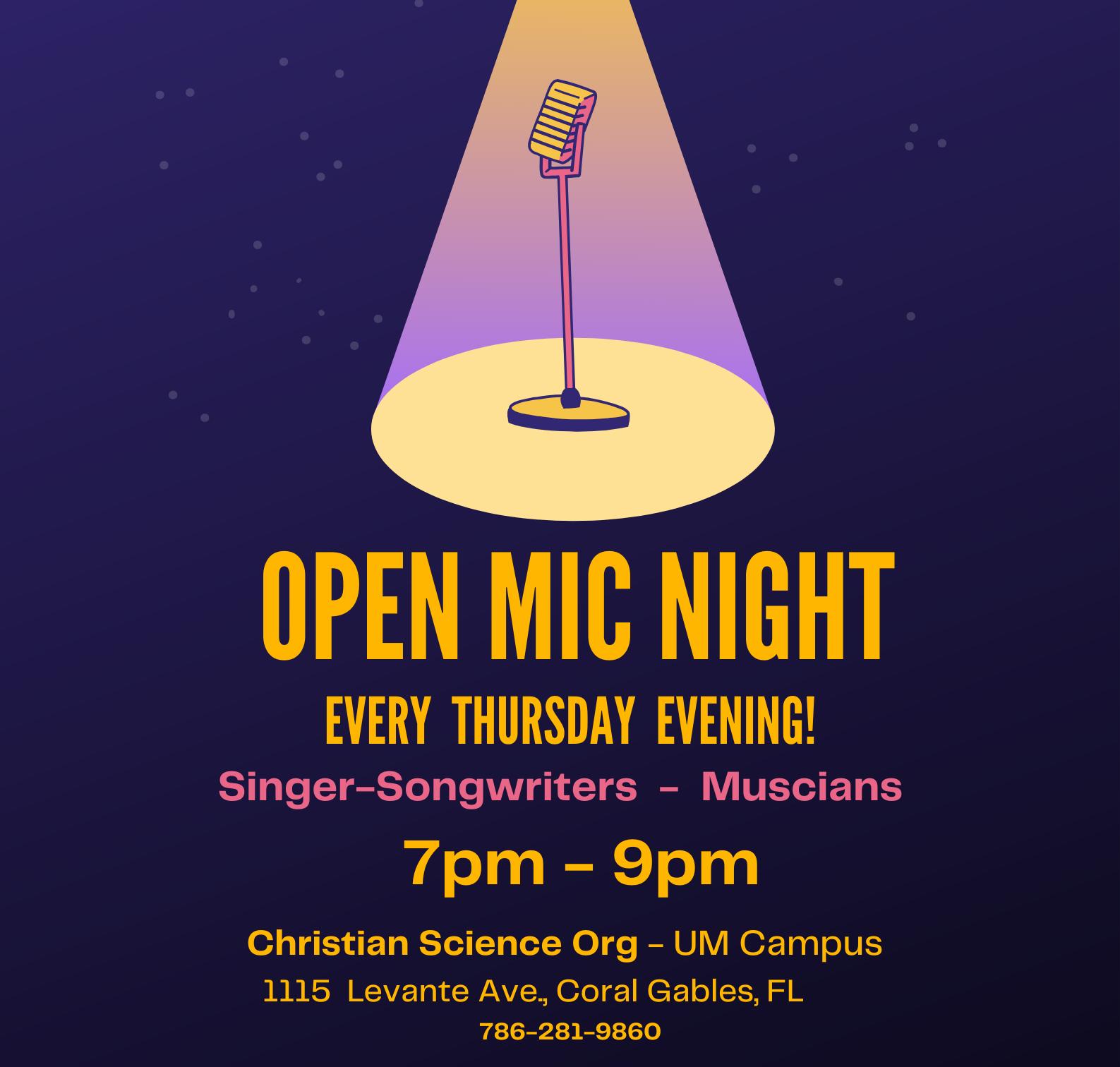




By Mel Tenkoff Assistant News Editor
Freebee, the free ride-sharing service on campus, has accumulated 5,500 rides since its launch, nearly 10 times more than its predecessor, SafeRide. Following UM Student Government advocacy, the late-night service has expanded its 7 p.m. to 4 a.m. weekday services to also offer weekend rides.
The transition was driven by collaboration between SG, Parking & Transportation and university administration and is tailored to offer a sustainable solution to late-night transportation.
“Freebee is a perfect example of SG utilizing its position as the ultimate advocate for students to implement changes that directly benefit students,” SG President Roy Carrillo Zamora said. “This is the no-brainer kind of project that SG excels at and that tangibly improves the student experience. I think this is what SG should always focus on.”
In the 2023-2024 academic year, Emmanuel Clemente, the University Affairs Chair at SG at the time, conducted a largescale student survey and introduced a bill to collaborate with Lyft to provide trans-
portation to and from campus.
Administration rejected the Lyft proposal, so the announcement of a partnership with Freebee at the beginning of the 2024-2025 academic year came as a pleasant surprise to SG members and students.
“The SafeRide program has evolved into Freebee, which the University of Miami Parking and Transportation Department put in place in Fall 2024,” the University of Miami said in a statement to The Hurricane. “Freebee custom designed its service area to cater specifically to students and where they frequent. Rides must either start or end on campus to be eligible for the service.”
Following its launch, students responded positively to the service. Less than two months after the start of the 2024-2025 school year, Freebee had provided 396 rides, more than half of the 559 rides SafeRide provided in 2023.
“I would say I use Freebee once or twice a week,” Alissa Spence, a freshman at UM, said. “It allows me to save money on places close to school.”
Even though first-year students are not allowed to have cars on campus, the University provides a variety of alternatives, including Metrorail, Hurry ’Canes
Shuttles and others.
Of these options, Freebee’s late-night transportation is key to creating a secure campus. According to the U.S. Department of Justice’s Bureau of Justice Statistics, violent crimes off campus were 50% more likely to occur at night.
What sets Freebee apart from its predecessor is its “efficiency and effective” use, according to the University of Miami. Unlike SafeRide, Freebee operates through the UMiami App and allows stu-
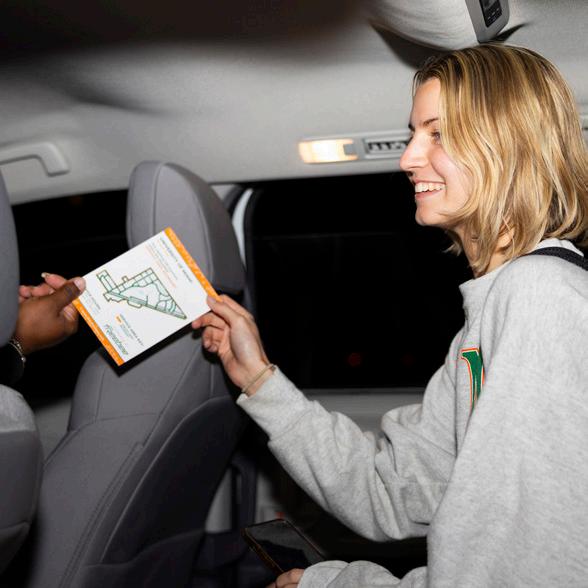
Alexandra Fisher
// Co-Photo Editor
Senior architecture major Samantha Nowak orders a Freebee to her home in Coral Gables to get to campus for a late night study session on Feb 17, 2025.
dents to request rides, track vehicles and get more accurate pickup times.
Freebee was only available on weekdays between 7 p.m. and 4 a.m. but has extended service to the weekends as a pilot program through the spring 2025 semester.
According to UM Parking and Transportation, the department “met with Student Government and the Dean of Students Office to gain feedback on the switch to Freebee. Student input guided the decision for the extended hours now being offered.”
Cecilia Ramirez and Bhavya Sharma, current chairs of the SG Senate University Affairs Committee, helped execute and pass the Freebee bill that expanded its services.
“Senate has been pursuing a free or subsidized ride-sharing service for years now,” Ramirez said. “After the incredible results [of Freebee], we knew we had to expand its availability to the weekends so that more students could benefit.”
As director of SG’s University Affairs Committee and leader of the Campus Liaison Council, Branden Logatto’s role involves bridging student voices and administrative initiatives. When his team saw the success and potential of the ride-sharing
program, they worked together to advocate for the expansion to the weekends.
“This academic year, I personally meet monthly with Parking and Transportation Administration, Eli Stephan and Shane Plageman, in addition to my Parking and Transportation Liaisons, Emily Cleary and Layla Hilmi,” Logatto said. “We [are] able to clearly communicate the success of the service to the administration.”
After consulting with Heather Stevens, SG advisor and assistant to the senior vice president for student affairs, SG developed a survey to gather feedback about how students would like to see Freebee expanded.
“We had over 500 student responses, showing administration that the expansion of this service was a priority of the student body,” Logatto said. “Though we experienced some bumps in the road due to additional funding needed for the service, we were able to work with administration to successfully launch the weekend service of Freebee this past January.”
According to Zamora, SG’s future plans for Freebee advocacy include adding a third environmentally friendly car to the fleet and tracking usage of the service to explore ways to improve the experience.
By Melody Royaee Staff Writer
It is not everyday that sharing the bench with a criminal circuit court judge is a part of your course curriculum. Each semester, students aspire to get into classes taught by UM’s judgein-residence, the Honorable Ellen Venzer, B.B.A. ’84, J.D. ’87.
A UM professor and lecturer for over 20 years, Venzer’s current course offerings are POL 324: Crime and Punishment and POL 325: Hot Topics in Criminal Law.
Her courses are so sought after that she received over 50 emails from students requesting an access code for enrollment this spring.
“Judge Venzer’s class is not a traditional class, but an experience,” said Lauren Bricca, a senior majoring in
global health studies. “It is one of the only classes that I have taken in my four years at the U that has involved experiential learning and in-depth discussion.”
The courses are structured as once weekly seminars, with Venzer and 12 to 15 students engaged in roundtable dialogue. Readings are derived from various law experts and publications, representing perspectives from across the political spectrum.
“I think it’s invaluable to be able to discuss different opinions and different views on topical issues of the day,” Venzer said. “If you can have open discussions with people with differing perspectives, you can learn so much more than just by being in an echo chamber.”
“She constantly asks follow-up questions, presents counterpoints and asks us to evidence our thinking, which really forces you to think critically and also see the other side,” said Anna Co-
hen, a senior majoring in political science. “It’s so much more personal than a lecture-based class.”
Venzer, a double ’Cane, began her legal career as a trial lawyer specializing in lender liability and securities litigation. In 2004, she was appointed by thengovernor Jeb Bush to the 11th Judicial Circuit of Florida, where she has since presided in the felony criminal circuit.
In 2019, Venzer became UM’s inaugural judge-in-residence. The program is funded by private philanthropist Nancy Hector, who seeks to “ready students for contemporary citizenship by giving them practical experience in how the American legal system shapes, informs and affects key issues of justice in our time — equity, inclusion and fairness,” according to the College of Arts and Sciences’ website.
“We really do have the fairest justice system in the world, but it of course
has its shortcomings,” Venzer said. Her courses cover a variety of hot-button issues regarding the justice system and incarceration in America.
Venzer emphasizes that being aware of these phenomena is an important part of a well-rounded education. “ I want to inspire curiosity and pique my students’ interest in how the justice system works,” she said.
“A lot of students in college kind of forget what life is like outside of their bubble. Especially at University of Miami, where the culture is centered around partying, going out and having a social life. It’s easy to lose sight of the things that happen around you,” adds Sara Howard, teaching assistant to Venzer and first-year law student at Miami Law.
“I love being able to stay up-to-date at a time where so much is changing within the judicial system in Florida
and in the US,” said Cohen. “And she’s in a position where she can offer really interesting insight.”
Students in Venzer’s courses are expected to visit her courtroom and observe her on the bench at least once during the semester.
“Visiting Judge Venzer’s courtroom [was] an invaluable experience that furthered my interest in law. As a professor and a person, she is witty and insightful, adding an additional layer of enjoyment to the course,” said Bricca.
Venzer often shares in class that, while she loves her work, her true passion is teaching.
“What a privilege it has been to engage students in thoughtful, relevant conversation about issues of law and society that have a direct impact on their lives,” she said.
“I cannot recommend a professor or a class more,” said Bricca.
By Daniella Krasney Contributing Writer
“We adults have messed up the world for you,” Associate Supreme Court Justice Sonya Sotomayor said to a crowd of students at Miami Dade College. “If you’re relying on the adults to fix it, it ain’t gonna happen.”
The first Hispanic and third woman to serve on the Supreme Court addressed college students during a fireside chat with Maribel Pérez Wadsworth, CEO of the Knight Journalism Foundation, on Wednesday, Feb. 12. During her talk, she inspired future civic leaders and urged students to drive meaningful change.
Sotomayor spoke of her experience growing up in the projects of the Bronx, New York, raised by two working-class Puerto Rican parents. She later graduated summa cum laude with a bachelor’ degree in history from Princeton University and attended Yale Law School.
“I didn’t grow up in an environment where I actually believed that I could become something great,” she said.
After law school, Sotomayor began her career at the Manhattan District Attorney’s office, while many of her classmates pursued higher-paying jobs in corporate law.
One student asked Sotomayor how she stayed true to herself, rather than relying on external validation through money or fame.
“I didn’t aspire to be a Supreme Court justice. I aspired to graduate from high school, college and law school and get a job,” she said. “As I pursued this, I took every opportunity to take one step forward.”
Madeline Pumariega, president of Miami-Dade College, spoke exclusively to The Hurricane. She hoped that students were particularly inspired by Sotomayor’s ability to drive meaningful change by listening to others, grounded by her passion for the law.
“I think you could feel that thread through her life experiences. Her ability to take in and listen to people with diverse perspectives,” Pumariega said. “Follow your passion. Stay focused on doing good.”
Sotomayor emphasized that young people have an obligation to be active members of the community. Her mother,
a nurse, instilled in her the importance of service by being the go-to medical professional for their neighbors.
“For someone who had nothing, she wanted to help people,” Sotomayor said.
“From the women in my life in particular, I saw that community building is not about taking on the big projects, it’s taking on the little ones, too.”
Before joining the Supreme Court, she served as a judge in the U.S. District Court of New York, appointed by President George H.W. Bush, and later on the Second Circuit Court of Appeals, appointed by President Bill Clinton. She was the first Latina to hold both positions.
Having worked at multiple levels of the judicial system, including as Manhattan’s District Attorney and as a corporate litigator, Sotomayor expressed concern over the voting rate among youth, which hovers around 50%, according to Tufts Circle.
“I firmly believe that in a republic like ours, voting is our voice,” she said.
“I don’t care if you don’t like politics. [Laws] don’t change by being a bystander and letting things you don’t like roll over you.”
Sotomayor cautioned students to critically evaluate their sources and avoid relying on a single perspective.
“Don’t trust that any one news source is giving you the whole picture,” she said. “No matter how reliable you feel they are, that is a dangerous practice in a world that has changed so dramatically.”
Sotomayor reflected on her own experience when she was a student, recalling a time when there were a few trusted
networks. She credits the rise of the internet and social media with the spread of misinformation.
“Now I turn on the TV and I don’t know where to start,” she said. “The internet is creating an extraordinary challenge to the press and the world.”
Nominated by President Barack Obama in 2009, Sotomayor became the first Latina justice to serve on the Supreme Court. She says that embracing new experiences while staying true to one’s roots is key to success.
“I have never denied my culture,” she said. “We have to enjoy the new things and become a part of them and take with us who we are.”
Sotomayor shared her experience with dissent on the Supreme Court, where there is a 6-3 majority of justices appointed by Republicans versus Democrats. This split, she says, is what poses challenges to consensus-building but also underscores the value of judicial debate.
“My colleagues who I disagree with frequently are not bad people. All of us love this country,” Sotomayor said. “Law is not black and white; it’s grey.”
Sotomayor did not mention President Donald Trump by name in her remarks, noting that she would not be “getting too much into that.” But as President Trump and allies seek to challenge court rulings, Sotomayor emphasized the importance of the law to maintain democracy.
“Our founders were hellbent on ensuring that we don’t have a monarchy,” Sotomayor said. “Court decisions stand whether one particular person chooses to abide by them or not.”
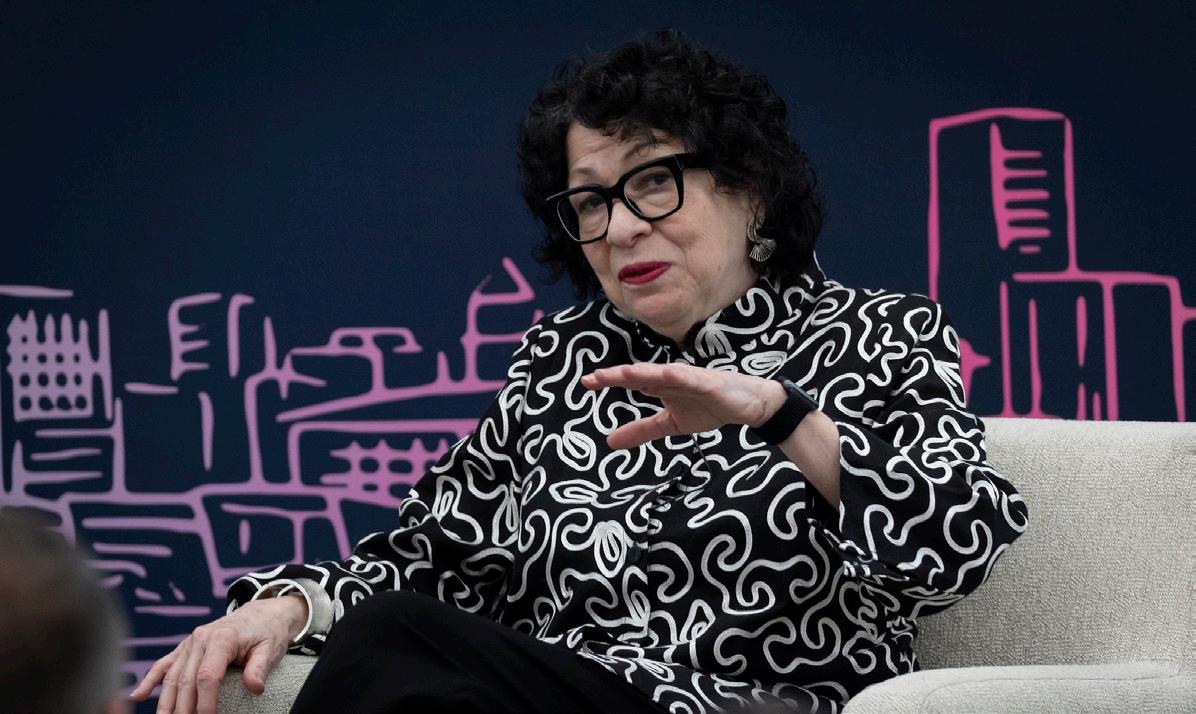
By Kelby James Contributing Writer
The Students of Culture Symposium, previously known as the Students of Color Symposium, has undergone a name change in response to feedback from alumni and current students to foster a sense of belonging for everyone.
“We understand that everyone at UM comes from different backgrounds and has unique experiences that ultimately lead us,” Executive Co-Chair of SOCS Sidra Alktaish said in a video posted on UM’s Office of Multicultural Student Affairs Instagram.
This year’s theme is “The Story of We: Echoes of Yesterday, Voices of Today,” which strives to explore the power of community through shared oral histories to connect the past to the present. SOCS is an annual initiative run by the Office of Multicultural Student Affairs and a robust student committee.
Students should look forward to participating in dialogue about culture and social issues through interaction workshops, thought-provoking discussions and collaborative activities. The event will take place on March 1 from 9 a.m. to 2 p.m. in the Shalala Student Center Grand Ballroom. Students and faculty should register for SOCS on MSA’s Engage.
The Florida Atlantic University Board of Trustees unanimously voted to appoint Adam Hasner, a former member of the Florida House of Representatives, as the university’s eighth president. On Feb. 7, FAU students gathered around Boca Raton’s Student Union to protest Hasner’s presidential forum before he was officially announced as president on Feb. 10.
The protest was organized by the student-run organization College Democrats at FAU. During the demonstration, students expressed their concerns about Hasner, being a Republican politician, bringing politics into his job if elected president.
Similarly, protests erupted on Florida International University’s campus following the appointment of Florida Lieutenant Governor Jeanette Nuñez as interim president. With Governor Ron De Santis’ support, Nuñez’s hire was approved 11-1 by FIU’s Board of Trustees. Students and faculty protested outside the Graham Center as the outgoing President, Dr. Kennet Jessell, received a standing ovation at his final Board of Trustees meeting. Despite the backlash, Jessell expressed confidence in the two-time FIU alumna.
By Samantha Rodriguez A&E Editor
Every time Samantha Fuentes enters a room, she looks for the exits. Then, she identifies all the places where a shooter could barge in. It’s a habit she’s developed since two of her classmates were shot and killed at Marjory Stoneman Douglas High School on Feb. 14, 2018.
Fuentes had hoped to leave the worst day of her life behind until she was subpoenaed to testify at the shooter’s sentencing trial in 2022.
“Sorry, here’s an obvious question,” Fuentes asked the state prosecutors in a virtual meeting. “[The shooter’s] not going to be there, correct?”
The state prosecutors met her eyes.
“No, he will be.” Her heart dropped. Fuentes had months to prepare to testify in front of the shooter. It was the hardest thing she had ever had to do.
Her tear-jerking journey to look her friends’ killer in the eye became the Oscar-nominated short documentary, “Death by Numbers.” Peabody-Awardwinning director Kim Synder helped Fuentes transform her pain into a rally cry for gun violence survivors.
The documentary created a powerful art piece on gun violence that reached
the Academy of Motion Pictures Arts and Sciences. Synder sat with film producer Maria Cuomo Cole with Sam on Zoom waiting to hear this year’s Oscarnominated films for best short documentary at 6:30 a.m. on Jan. 23.
The category arrived, and “Death by Numbers” was the first film announced. Excitement flooded the air as Fuentes got overwhelmed with emotion. Synder and Fuentes then reunited in London and couldn’t stop talking about how to keep the conversation
about gun violence going.
“It’s the first film to ever be nominated for an Oscar that’s actually been co-created by a gun violence survivor,” Synder said. “That’s something we both feel very strongly proud of.”
Synder brought Fuentes’ words alive in the film. Poems Fuentes wrote during her healing journey became personified with archival, black-and-white footage and a gothic, classical score. A shadow shaped as the grim reaper crawled across the screen as Fuentes recalled when she
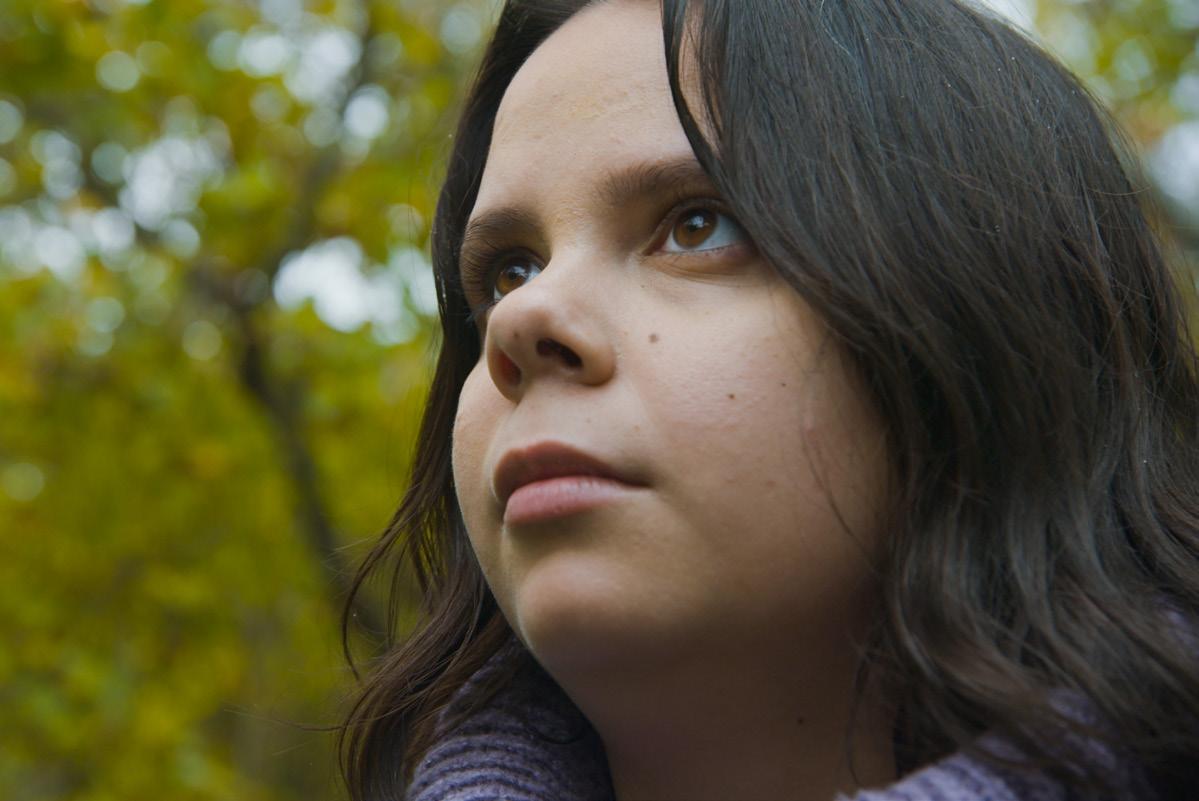
saw the shooter peeking into her Holocaust Studies class.
Her forward narration describes indescribable anger and grief. Viewers can see Fuentes getting teary-eyed calmly watching the trial.
“Sam was always open to having her most vulnerable moments recorded,” Synder said. “It was a perfect collaboration where I have a certain amount of experience and craft, and together with her words, we’ve built something powerful.”
The source of Fuente’s pain is rarely mentioned or seen in the documentary.
A large black ‘X’ covers the shooter’s face almost every time he’s on screen.
Synder and Fuentes avoided mentioning or showing him unnecessarily to limit his notoriety.
His face only comes into focus when Fuentes delivers her victim impact speech. Families of murdered students sat in the pews as Fuentes approached him dressed in black. She took a deep breath before looking him in the eye.
“Do you remember, after you sprayed my classroom with bullets, standing in the door frame, peering in to see the work you’ve done? Do you remember my little battered, bloody face looking back at you?” Fuentes said. “I could’ve sworn we locked eyes.”
Contrary to most of Fuentes’ speech-
es in the film, her final one had no visuals. Instead of dramatic music, the silence from the crowd ignited her words. Synder allowed Fuentes’ rage to speak for itself.
“When she does that speech, she taps into a larger zeitgeist of what’s happening in the world right now, a feeling of people feeling powerless,” Synder said. “By looking at him and calling him out, he doesn’t matter anymore. Her putting that out into the world is some energetic, hopeful and positive thing.”
The duo works with organizations like the Sandy Hook Promise nonprofit to address escalating gun violence as one of the largest killers in America. They attend international film festivals to promote the film and keep the conversation alive.
“We need to really take in the hundreds and thousands of Sams that are in cities across America that witness gun violence, lose parents, friends and siblings,” Synder said. “One of our friends in Chicago said he’s been to more funerals of friends from gun violence than he had been to graduation parties.”
Synder and Sam look to use the bravery from survivors to stand up to hate. Catch them at the Oscars on March 2 bringing the conversation about gun violence to the red carpet.
Orange Umbrella’s Super Bowl ad shows Doritos are the chip that counts
By Samantha Rodriguez A&E Editor
Doritos have been a staple Super Bowl snack for decades. The University of Miami’s Orange Umbrella reinvented the iconic brand as not just a chip, but a lifestyle in the student-run ad agency’s ad submission for Doritos’ Crash the Super Bowl contest.
Unfortunately, they didn’t make it into the final round. Still, Mavorah is confident the agency will never forget the experience and Orange Umbrella looks forward to trying again next year with more tricks up its sleeve.
The contest invites creators from around the world to develop a Doritos ad that will make watchers turn off the TV
and run to get that nacho-cheese taste.
Winners would receive $1 million, a trip to New Orleans, and have their ad aired before over 100 million viewers during football’s biggest night.
The student-run ad agency heard about the competition four weeks before the submission deadline. Orange Umbrella Managing Director Ian Mavorah split students into groups to have them create multiple ad ideas and pitch them.
“When I found out they were doing it again, I thought this would be a great project for the team,” Mavorah said. “I mentioned it to the agency, we voted, and it was unanimous.”
UM senior Liam Kirkpatrick’s team’s idea was the winner. They imagined a romantic date where the boyfriend’s card doesn’t go through, so the girlfriend
thought to pay with a Dorito.
She opened her purse, which had dozens of Doritos inside, and pulled out the best one to put into the waiter’s chip reader. The commercial then cuts to the Doritos logo and mantra, “For the Bold.”
Kirkpatrick and the agency’s video team set up in a local restaurant and spent four hours bringing their vision to life.
“The most difficult thing was getting actors together,” Kirkpatrick said. “Putting together people that we think of going to be of substance quickly and under time and budget was really important.”
Audio was another challenge. The restaurant was near a Metrorail station, and any passing train covered the actors’ dialogue from getting recorded. With minutes ticking by, the crew would wait for the trains to leave, which
were coming every “four minutes in between each take.”
Orange Umbrella Vice President of Public Relations Ava Prinzo watched it unfold as an extra.
“Our video team really excelled at bringing the whole thing together,” Prinzo said. “We had such a great idea, and seeing them take that idea and apply it to that scale, it was really incredible.”
After hours of editing, the agency submitted its ad to the competition. It ended up in the Doritos gallery for the nation to see and vote on.
The agency is eagerly anticipating next year’s contest so they can take their new submission to the next level.
“At the end of the day, based on all the obstacles, the timing we had, I think they knocked it out of the park,” Mavorah said.
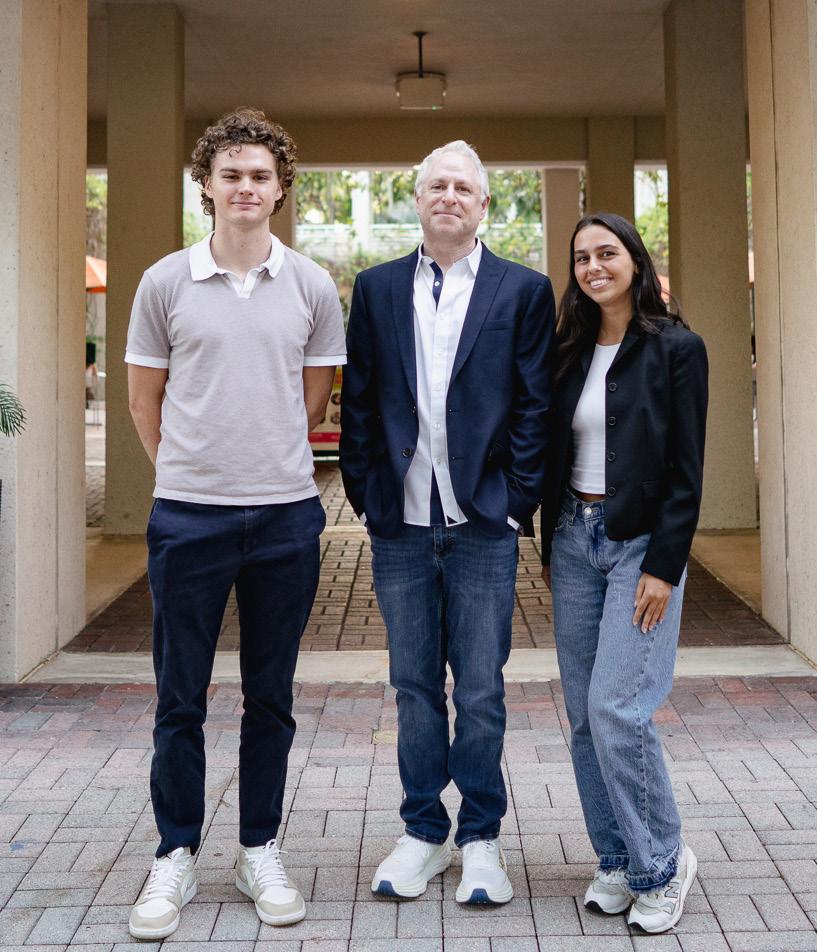
By Samantha Rodriguez A&E Editor
Actor Danny Ramirez dreamt of leaving Miami when he was eighteen. Having touched ground in the 305 for the second time in years on Feb. 16 after leaving to study acting in New York, he’s surprised he ever left.
To Ramirez, there’s no Miami without the ‘U.’ Ramirez has been a ’Cane’s football fan since first grade. Seeing Santana Moss, a ’Canes wide receiver, play one of his best games while on a Boy Scouts trip showed him heroes can come from Miami too.
Now, Ramirez is a Miami hero of his own. When Marvel approached him and asked how they could make his character Joaquin Torres more authentically from Miami, there was just one thing Ramirez had in mind.
“I told them, ‘He has to be a ’Canes fan’,” Ramirez said.
He urged them to put his character in a Hurricanes jersey, which did make it into a deleted scene, but they settled on having him sport a green ’Canes football shirt with the ‘U’ for a scene in the final cut.
Though Hollywood has embraced the rising star with his role in Tom Cruise’s “Top Gun: Maverick” and the Emmynominated series “The Last of Us,” to him, there’s nothing like Miami.
“In Miami, I was able to be in an area that was basically the middle of Latin America. Everywhere I went everyone’s speaking Spanish,” Ramirez said. “Every third person is going to be the most charming person you’ve ever met.”
Miami hasn’t left Ramirez. Upon arriving to the University of Miami’s School of Communication’s broadcast studios to prepare for an interview with student media, he rushed toward a tray of pastelitos.
He quickly grabbed three guava pastries before getting touched up by his makeup artist.
“You feel at home yet?” she asked.
Ramirez went from getting interviewed by the University of Miami’s student media, to throwing the first pitch at Mark Light Field, hosting a meet-andgreet at the Bill Cosford Cinema and greeting guests at AMC Sunset Place at 9 p.m. He wouldn’t have it any other way.
“This city has so much of that vibrancy that I used to fight against,” Ramirez said. “To be back and realize that a lot of it has shaped me as an artist in my identities is the cool part.”
Ramirez was at almost every football game during the 2024 to 2025 football season with quarterback Cam Ward (who he’s confident will be the number one draft pick in April).
When asked about football, he’d go on about the game-winning block in the ’Canes game against Virginia Tech and how he’s sure he developed a heart condition while watching the Syracuse match.
His love for the ’Canes and Miami knows no bounds. While the lengths he’d go to watch a ’Canes game are un-
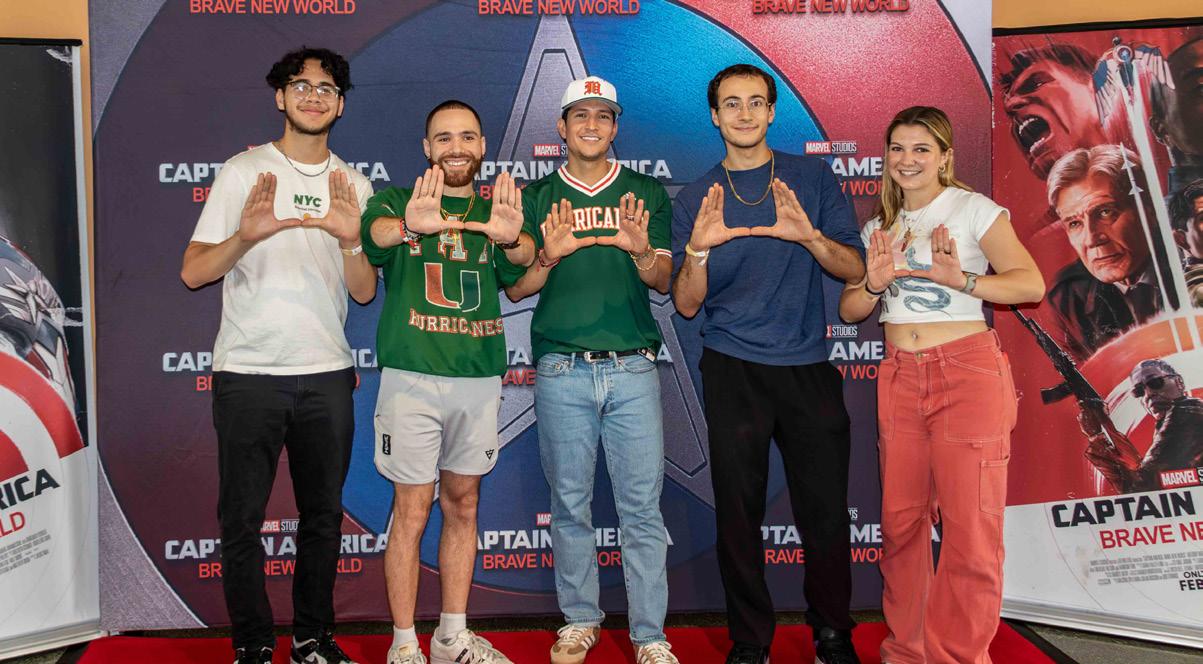
certain, one thing is: he’d really like an honorary degree.
“Shout out to anyone in charge of giving the masters,” Ramirez said. “Just at the end of the article be like, ‘Honorary degree? Maybe?’”
Ramirez is heading back to Los Angeles, yet his heart remains in Miami and will happily let the cardiac ’Canes make it skip a few beats.
Don’t miss Ramirez as the Falcon in “Captain America: Brave New World” and keep an eye out for all the references to his hometown and the U in the hit film.
By Tatiana Pina Contributing Writer
Celebrating its 61st year, the Coconut Grove Arts Festival featured over 280 artists and attracted over 100,000 attendees over the course of three days.
This cultural mecca invites people to immerse themselves into a new world of art, music and culinary delights. By providing a platform for artists to exhibit their work, attendees can build a personal connection with the art that surrounds them and the artists themselves.
The festival showcases a wide variety of art forms, including paintings, collages, sculptures, photography, jewelry, instruments and clothing, each reflecting the artist’s unique style. The passion these artists bring to their craft breathes life into stories and sentiment.
Mike Maydak, a fantasy illustrator, creates imaginative worlds filled with intricate details that depict vivid narratives inspired by video games and comics. As a former writing major and short-lived journalist, he has always had a passion for storytelling.
“I learned a lot from visual aesthetics
and what goes into a story,” Maydak said. “I want my audience to spend some time there and also put a lot of thought into their own story. In that way, we are making a connection through the artwork.”
Storytelling is a central component for many artists at the festival, including for Marge Luttrell. Luttrell is a wax-painting artist, who uses collages to explore the meaning behind Greek mythology. She is a master at the encaustic technique – an ancient Greek method of painting with beeswax – to honor its historical significance. She combines different media, portraits of women and men, while incorporating some abstract elements as well.
“I just wanted to do an homage to the fact that it is still even around,” Luttrell said.
Her pieces encapsulate the feeling of being in a dreamscape, with an emotionally charged color palette and layered compositions open to interpretation.
Luttrell has exhibited her work at CGAF on and off since 1984. Over the years, she has witnessed how her art has inspired and even uplifted others. Marge recalled a moment when a man purchased one of her pieces for his wife who was battling cancer.
“He said this might uplift her because it’s about forgetfulness and it’s medicine for sadness,” Luttrell said. “You don’t know how your art touches people.”
Art resonates with everyone in different ways, whether it is through the comfort it provides someone or the sense of abundance it evokes. Nnamdi Okonkwo,
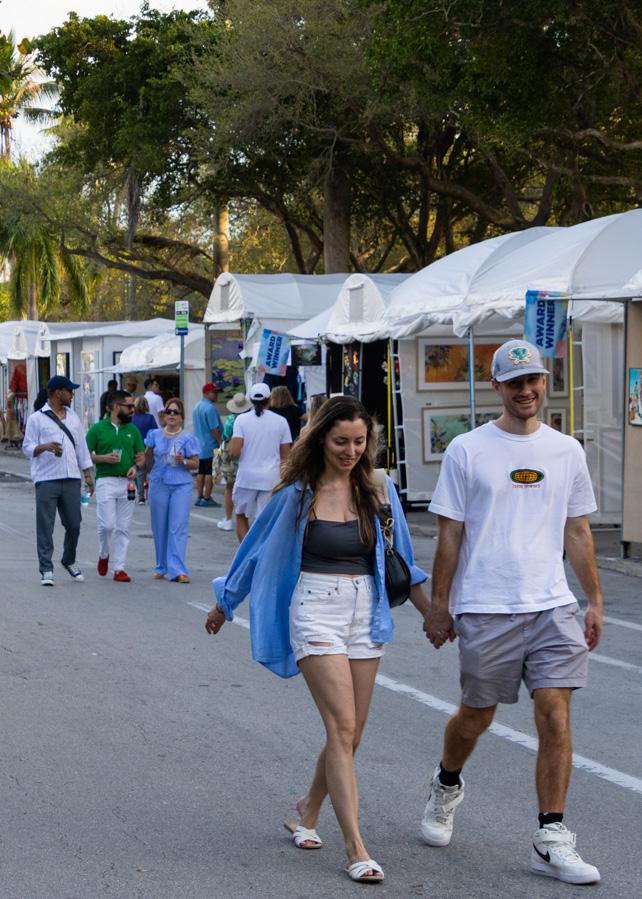
a sculptor, uses his art as an extension of himself to showcase his vast soul. The focal point of his sculptures are often curvaceous women, depicted with fluid, flowing movement. His voluptuous and curvy figures piqued many attendees’ interest for the comforting emotion it evokes.
“Each of these have their own soul,” Okonwo said. “I hope that the peace and tranquility will reflect a little back to them.”
To many attendees, what we wear is important. It is an extension of our soul and how we express ourselves. Betsy Giberson, a former sculptor and now designer, has found that making clothing to adorn the most realistic sculptures of all - people - is her purpose. She wanted to make clothing that empowered women and men, but that was also practical and aesthetically pleasing.
“It’s a challenge because bodies aren’t geometric,” Giberson said.
Her clothing displays geometric patterns, drape material and her own personally designed color pallet.What makes Betsy’s clothing special is that she is involved in every part of it, from sewing, to creating the patterns and dying the cloth.
The intimacy she finds in making clothing differs from sculpting, as the heavy material requires collaboration and assistance from other people.
With such a wide variety of artwork to browse and purchase, the experience can be overwhelming. However, for many attendees, this is their first time at CGAF, making it an exciting introduction to the festival.
“It’s been fun to look at,” Sally Work, a first time attendee said. Although she was not able to purchase any art work, because, “ a lot of it is high end work and priced accordingly,” she was fulfilled with the experience of seeing new artwork, especially as a fellow artist.
The Coconut Grove Arts Festival has given attendees a bit more than just a new piece of art for their homes. It has offered them fresh perspectives, long lasting memories and shared stories. For artists, witnessing people connect with their art, it is a deeply rewarding experience affirming the power of storytelling through art.
More than just a festival, CGAF serves as a bridge between people, stories and culture, making it a source of inspiration and a truly unforgettable experience.
By Jenna Simone Staff Writer
A tall red sculpture near Lobby A of the University of Miami’s Lakeside Village is already sparking conversation among students and faculty. During the beginning of second semester, the entrance to Pavia garage was blocked for days at a time to make way for the sculpture’s ongoing construction.
American sculptor John Henry designed the sculpture, which has now been brought to the campus, showcasing the artist’s signature style of combining geometric forms, monumental scales and primary colors.
“Lady” is a bright red sculpture with welded steel beams pointing in different directions. The sculpture’s height is approximately 70 feet tall compared to his previous works such as “Complexus,” serving as an artistic statement.
The title of Henry’s sculpture, in addi-
tion to its shape and single skyward-reaching beam, recalls the Statue of Liberty.
Henry is known worldwide for his large-scale public works of art. His large pieces are presented in numerous museums, corporate, public and private collections as well as the collections of many American cities and states. His works are also exhibited in the public collections of various European and Asian communities.
Donated by the Palley Family in honor of their parents Sheldon and Myrna Palley, long-time University supporters and alumni, “Lady” is a testament to the Palleys’ philanthropic investment in both the University and wider Miami-Dade community.
The sculpture speaks to Sheldon and Myrna’s belief in the power of art to touch lives, a belief shared by the Lowe Art Museum. The Lowe is an integral part of UM, exhibiting a wide variety of art from around the world with over 19,000 pieces in its collection. This Lowe is also the
proud home of The Myrna and Sheldon Palley Pavilion for Contemporary Glass and Studio Arts.
The Palley Pavilion houses a stunning $3.5 million glass collection with masterpieces by some of the most talented international artists. The Palley Pavilion opened in 2008 thanks to the vision of Sheldon and Myrna Palley, who donated $1.7 million towards the construction of the Pavilion, and whose collection is a promised gift.
Striking in nature, some students are having a hard time understanding the deeper meaning behind its minimalist design.
“I don’t understand the significance of the sculpture,” Harley Carlin, a freshman marketing major, said. “There’s not even a plaque describing it or who made it.”
As it was being built, the sculpture sparked conversations among students, with opinions ranging from confusion to appreciation. Other students share this frustration, wishing for more context
about the piece.
“I think the sculpture is odd,” Ava Ferrara, a freshman pre-law student, said. “I wish it was something students could more commonly understand.”
The contrast between the sculpture and existing campus designs has also been a point of discussion. While it may be confusing at first glance, some see it as a piece that complements the university’s artistic atmosphere.
“I think it matches some of the other sculptures on campus, like the brown one near the library, but it’s not exactly my taste in art,” Lucas Coffman, freshman marine science and biology major, said.
Looking past the campus itself, visitors observe that the sculpture’s modern design may align with the city of Miami’s vibrant aesthetic and contemporary feel.
“I just feel like it’s kind of misplaced and too bright, but I can also see how it fits the modern aesthetic of our campus and the city,” Karina Desai, freshman business major, said.
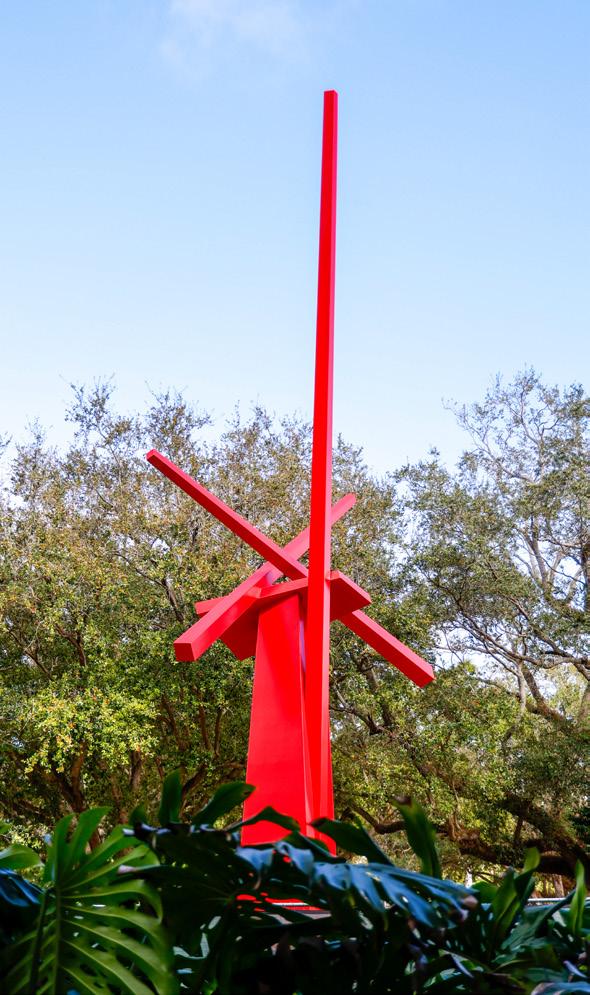
By Nicole Franco Contributing Writer
Last year’s Barbienhemeir phase dominated the Oscars as cinephiles rested easy knowing Christopher Nolan’s “Oppenheimer” will likely sweep. The script has completely changed for the 2025 race.
With so many hidden gems, tightnip competition is on the rise for these films on the big break. Earning 13 nominations, “Emilia Pérez” has become a frontrunner, but its controversy leaves a bigger play ahead. With “Conclave” winning Best Picture at the BAFTAs and “The Brutalist” getting Best Drama at the Golden Globes, the night’s final victory is riddled with uncertainty.
Best Picture
From romance to social commentary on the racial, political and economic outlooks of the world, the Best Picture category features an array of films.
Romantic drama “Anora” is a modern take on a “Pretty Woman” story through the lens of a sex worker and the son of an oligarch. It highlights the complexity of a
romantic relationship and touches on major themes like women empowerment and mistreatment as well as power imbalances. The film has boosted its odds, collecting a top prize from the WGA with Best Original Screenplay and fostering even more favor in both the PGA and DGA.
The novel adaptation “Nickel Boys” by Colson Whitehead depicts racial discrimination and brutality. From paper to the screen, audiences are given a taste of the corruption of Florida reform schools in the 1960s from the perspective of two African American boys sent due to unfair juvenile sentences.
“Nickel Boys is important because it exposes a nasty, disturbing tale in Jim Crow South. I wish there was more heat on this film. It’s a chilling story, and one we should use as a wake-up call for 2025,” said Betsy Mateu, a lecturer in the University of Miami’s cinematic arts department.
“The Brutalist” is the longest movie on the list, with a runtime of over three hours. The film does not shy away from powerful performances and exploration of the immigrant experience through an architect who aims to restore a new life in New York. Walking away with four awards at the BAF-
TAs, the film becomes a likely favorite. Secrets of the Roman Catholic Church through the appointment of a new pope are uncovered in the investigative thriller, “Conclave.” This film is another strong force, as it has already gotten to the public eye in the BAFTAs, where it won Best Picture.
Great contenders for Best Picture have made their mark. Directors like Sean Baker for “Anora” and Brady Corbet for “The Brutalist” are in the running for one of the biggest awards for directors in Hollywood.
Although acknowledged as an amusing and fantastic piece of work, Jon Chu did not receive a nomination for “Wicked,” another snub similar to that of Greta Gerwig for the empowering “Barbie” at last year’s Oscars.
Jacques Audiard’s musical and crime piece “Emilia Pérez” is surrounded by controversy due to the conflicted portrayal of the transgender experience and the lead actress’ X scandal. It follows the story of a retired cartel boss. The film has received mixed reviews despite Audiard’s public apology statements and
remains a competitor.
“I personally liked Emilia Pérez, although I think that the controversy is warranted,” Mateu said. “Thousands of Mexicans have gone missing and the concern is that this has been trivialized.”
This year, popular choices for Best Actor, Best Actress, Best Supporting Actor and Best Supporting Actress have been circulating. The competition is close, as many nominees have given phenomenal performances.
For Best Actor, the battle between Adrien Brody in “The Brutalist” and Ralph Fiennes in “Conclave” has ensued, with both films competing in the Best Picture category. Among big names like Timothée Chalamat for “A Complete Unknown,” Sebastian Stan for “The Apprentice” and Colman Domingo for “Sing Sing,” the odds could tilt in unexpected directions.
The award for Best Actress in a Leading Role is up for grabs. A favored contender, Demi Moore’s Golden Globewinning performance in “The Substance” has become a strong force to be reckoned with. Many believe Moore has been over-
due for an Oscar, and she has wowed viewers through the embodiment of body horror, spirit and change.
Fernanda Torres in “I’m Still Here” has also delivered impeccable moments. One of which garnered a standing ovation of 10 minutes at the Venice Film Festival. Torres is only the second Brazilian actress to ever be nominated for an Oscar, the first being her mother in 1998.
The strong competition continues with Karla Sofía Gascón becoming the first openly transgender nominee for an Oscar, charting headlines. Powerful vocals from Cynthia Erivo in “Wicked” and the intimate performance of Mikey Madison in “Anora” remain at play.
Current favorites seen for Best Supporting Actor and Best Supporting Actress lie in the run with Kieran Culkin in “A Real Pain” and Zoe Saldaña in “Emilia Pérez.”
So whether you’re on the edge of witnessing one of the largest, most-anticipated nights of the film industry, the competition is sure to keep you at the edge of your seat. Tune in on ABC or, for the first time ever, Hulu for the 97th Annual Academy Awards hosted by Conan O’Brien at the Dolby Theater on March 2.
By Samantha Rodriguez A&E Editor
University of Miami Professor Kathryn Sue Freeman, known for making the stresses of her English students fade away with just a smile, died in her sleep at home on Jan. 24, 2025.
“My mind was rejecting it,” Rafaela Ochoa, one of Freeman’s past students, said. “I didn’t believe it.”
Freeman received her bachelor’s and doctorate in English literature from Yale before coming to UM as an assistant professor in 1992. Freeman has taught thousands of students over the years, though, being an educator was not the only role she played at UM.
department her all.
Watson was always in awe of her kindness and dedication to students.
“She helped them with their writing, thinking and presentation skills, they commented that her door was always open,” Watson said. “It’s hard to imagine that she’s still not up there one floor above in her office.”
Department Chair Jaswinder Bolian admired her persistence in developing the best English department for students. Though they would rarely talk outside of work, Bolina knew she was one of a kind.
“She would go from being warm, friendly Kathy to really inclusive, thoughtful academic Kathy,” Bolina said. “It was fun when she
“Her tone was very welcoming to us and she really encouraged discussion in the classroom. Myself and other students were just in awe of how intelligent she was.”
Rafaela Ochoa // UM student
Freeman also found herself helping Director of Undergraduate Studies Timothy Watson process faculty applications while he was department chair. While Freeman was typically fun and loving outside, she would readily flip her demeanor while working to give the
would switch gears and become the scholar in the room.”
Students imagined building their writing careers with Freeman at their side. Ochoa was originally a political science major before Freeman showed her a successful career in the demanding publication in -
dustry is possible.
Freeman emphasized that her classes were for everyone. Though they would dabble in 18th century literature in her romantic era courses, Freeman promised every student they would leave with a greater understanding of the text.
“Her tone was very welcoming to us and she really encouraged discussion in the classroom,” Ochoa said. “Myself and other students were just in awe of how intelligent she was.”
Freeman’s kindness was not without struggle. She balanced her incoming responsibilities with being a single mother while working on her scholarly books, like “Rethinking the Romantic Era” and “A Guide to the Cosmology of William Blake.” Still, Watson remembers how she was always graceful in the face of pressure.
“She did a lot of the invisible work that makes the University run, [the person] who will take notes, followup and volunteer,” Watson said. “Any large organization relies on people who do that work.”
Looking at student comments on Freeman from her last professor evaluations, Watson’s eyes were drawn to the student’s kind remarks, as if a piece of her lived in every word.
“I have students come to me saying, ‘I want to do a senior thesis, I want to work with Professor Freeman’,” Watson said. “They saw her as a model for somebody who combines research, teaching and generosity. It’s going to be very hard to replace that.”
The UM English department looks to preserve Freeman’s legacy by carrying out her dream ambition for the department, teaching more female authors. Faculty hopes to expand the literature used in class to expose students not just to acclaimed male writers, but underappreciated female authors who laid the groundwork for modern story -

Joel Wainberg // Staff Designer
telling.
The English department looks forward to planning her celebration of life in their first department meeting this semester.
“We’re trying to regroup and process the shock and grief and figure out ways to celebrate her legacy,” Bolina said. “For anybody you talk to in the department, the memories are all warm and good, so you want to honor those and that’s what we’re working on now.”
While it’s impossible to sum up what Freeman means to the University with one event, her colleagues know just treating each other with Freeman’s kindness will help the department remember her for years.
“She did a lot of the invisible work that makes the University run.”
Timothy Watson Director of Undergraduate Studies
Voting is open from Monday, Feb. 17, through Wednesday, Feb. 19 on Student Government’s Engage page. Results will be announced via Instagram, @umsgelections, at noon on Thursday, Feb. 20.
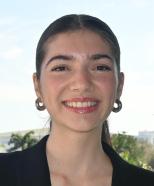

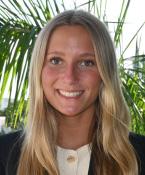
Ivana Liberatore is a junior majoring in finance and legal studies with a minor in political science. As a presidential candidate, Liberatore “promises a commitment to a Brand New U, one that defines the next century of innovation, inclusivity and collaboration.” She originally joined Student Government on the First-Year Leadership Council as a freshman, then became the university registrar liaison for the Academic Liaison Council as a sophomore. She now serves as Student Government’s assistant director of academic affairs and as an undergraduate representative for the Board of Trustees Student Affairs Committee. She has also been part of Alpha Kappa Psi, Latina Project, Orientation Fellows, Student Managed Investment Fund, Association of Latino Professionals for America, Undergraduate Dean’s Advisory Council and Association of Commuter Students. In the next year, Liberatore wants to extend her efforts further than she ever has. “From my first day at UM, I have been driven by the idea that student leadership can truly shape the university experience. Running for president is about taking that advocacy to the next level.”
Kylie Quintana is a junior majoring in political science and psychology with minors in business law and law and politics. She is “honored to present her candidacy for student government vice president” with Brand New U, where she wants to ensure “the next century of the U shines even brighter than the last.” At UM, she is a Presidential and Latina Project Scholar. On campus, she has served as an associate justice of the Student Government Supreme Court and led finances as vice president of internal finance for Alpha Kappa Psi, where she now serves as director of rituals. She volunteers at the Camner Center for Disability Services, serves as the community outreach chair for Girls of Outreach & Diversity and has logged over 200 hours at the Butler Center. For Quintana, becoming vice president would mean she could help foster the next generation of student leaders. “As vice president, I look forward to guiding the First Year Leadership Council as they begin shaping the first freshman class of UM’s next century, ensuring that the future of our university is built on innovation, inclusivity and purpose.”
Victoire Wuyts is a junior majoring in business analytics and legal studies. As a candidate for Student Government treasurer, “she is committed to strengthening the relationship between Student Government and SAFAC, increasing financial accessibility and ensuring equitable distribution of UM resources.” She is a Student Activity Fee Allocation Committee delegate, where she helped “allocate over $1.6 million across 306 student organizations.” She serves as vice president of internal finance for Alpha Kappa Psi, and she originally served as treasurer of Above the Bar, a pre-law organization, where she now is President. Additionally, she supports breast cancer awareness initiatives through Zeta Tau Alpha. She is also Foote Fellow mentor and Singer Scholar. For Wuyts, her first year as treasurer would be about making funding transparent, equitable and accessible for all. “Running for treasurer means ensuring that student organizations have the financial tools to grow, innovate and make a lasting impact on our campus.”
By Keira Faddis Contributing Writer
This year’s executive seats of Student Government elections have been split between two tickets, Brand New U and Next Century Canes.
Brand New U, with presidential candidate Ivana Liberatore, vice presidential candidate Kylie Quintana, and treasurer candidate Victoire Wuyts is “committed to empowering students, expanding resources and making sure every voice is heard,” according to their Instagram account. Their campaign initiatives center around student empowerment, accessibility and innovation, including supporting Cane Card integration with Apple Wallet, improving campus infrastructure and expanding financial and professional opportunities for students.
“My journey in Student Govern-
ment — from the First-Year Leadership Council to serving as assistant director of academic affairs and board of trustees undergraduate representative — has shown me the power of student voices,” said Brand New U presidential candidate Ivana Liberatore. “Running for president is about taking that advocacy to the next level.
Their key initiatives include a student leaders roundtable, where they hope to create a collaborative space for leaders from different organizations to share ideas, voice concerns and work on common goals. They would like to establish a Raising Cane’s location on campus and expand financial and professional opportunities for students. Their student services initiatives extend to providing free rides to the airport, supporting Cane Card integration with Apple Wallet, improving campus infrastructure and enhancing first-aid training for RAs.
“I believe in Brand New U because I know Ivana, Kylie and Victoire have characters that I can trust and the determination to do what’s best for our school,” said Nicholas Gavin, a freshman on the Brand New U campaign team. “I also appreciate their student body focused initiatives, especially professional development.”
Next Century Canes is made up of presidential candidate Isaac Jimenez and treasurer candidate Damian Gomez. According to their Instagram account, Next Century Canes is “about action: delivering results for [students].” Their proposed initiatives for the upcoming school year include increased funding for student organizations, increased student involvement and expanded opportunities for students. They also want to work to expand the dining hall hours, get discounts on transportation and offer more opportunities for students to become involved on campus and have
their voice heard.
“It is important to me to listen to all students,” said Next Century Canes presidential candidate Isaac Jimenez. “We will make sure we do this by having town halls where students can speak and that will lead to action from our part to make sure we are addressing the needs of the students. I am running for Student Government president to represent and deliver results for all students.”
Next Century Canes’ key initiatives are strengthening campus safety and promoting graduate school and career opportunities. They also want to strengthen alumni relations so that current students can have access to mentorship and career opportunities from fellow ’Canes.
According to Chapter IV, Title 3, Section 9 of the Statues to the Constitution of the Student Government, “Candidates may withdraw at any point. Any candidacy withdrawn after the applica-
Isaac Jimenez is a junior majoring in political science on the pre-law track. As a candidate for Student Government president, Jimenez is “excited to get to work” for the student body with the Next Century Canes ticket. He is dedicated to listening to students and having open communication, “including updates on what [he is] working on in the Student Government.” Jimenez currently serves as a Student Government senator for the College of Arts and Sciences, where he works on bills that help expand transportation options on campus, including one that will extend Freebee services to include weekends. He also serves on the Policy and Finance Committee, Student Activity Fee Allocation Committee and the University Affairs Committee. Jimenez hopes to prioritize making every student feel heard and represented in the next year if elected president. “I am running for Student Government president to represent and deliver results for all students … [My] experiences have prepared me to have a strong understanding of the needs that students have and a strong record of results that prove my ability to get things done for students.”
Damian Gomez is a sophomore majoring in accounting and business with minors in business law and Spanish. As a treasurer candidate, Gomez is “ready to be a part of the team that leads the Next Century into continued success.” He serves as a delegate on the Student Activity Fee Allocation Committee, treasurer of the Interfraternity Council and is the Business School liaison on the Academic Liaison Council branch of Student Government. He has experience “working with diverse individuals, communicating effectively, solving problems under pressure.” He has also “learned to balance different responsibilities, organize events and make decisions that benefit everyone.” He is confident that with the skills he has developed in his time at UM, he will succeed in leading the school’s finances if elected as treasurer. “Overall, the skills I’ve learned not only in my extracurriculars, but in class as an accounting and finance student, have equipped me with the necessary mindset to lead our school into the next centennial.”
tion deadline may not be reinstated.”
On Tuesday, Feb. 11, Next Century Canes’ vice presidential candidate Dominique Thomas, withdrew from the race and posted a statement to her social media explaining why.
“As the campaign has developed, it became clear that my vision and priorities for leadership do not fully align with the ticket I stood alongside,” Thomas said in the statement. “Rather than continue in a space where I cannot fully represent the values and initiatives most important to me, I believe it is best to step back at this time.”
Because of this, only one Vice Presidential candidate will appear on the ballot. The voter’s second option will be to abstain. A selection to abstain does not count towards the total vote.
Voting is open from Monday, Feb. 17, through Wednesday, Feb. 19 on Engage, and results will be posted at noon on Thursday, Feb. 20.
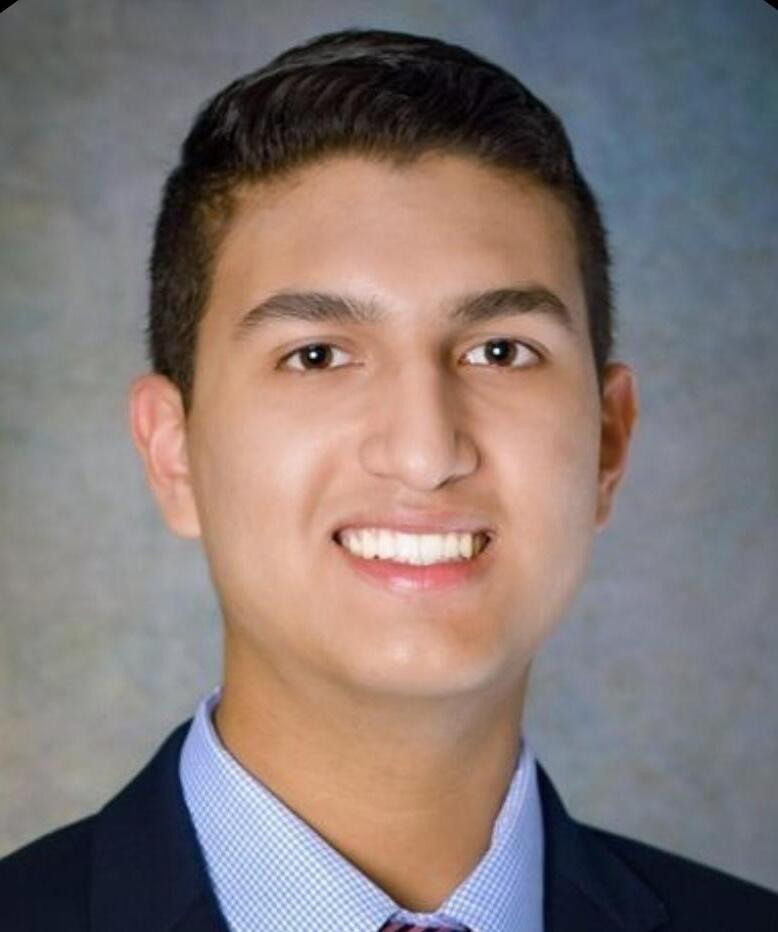
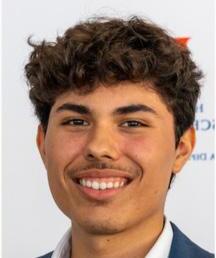
By Keira Faddis Staf Writer
President Donald Trump signed an executive order to ban transgender athletes from competing in women’s sports on Wednesday, Feb. 5, which happened to coincide with National Girls and Women in Sports Day.
The order, “Keeping Men Out of Women’s Sports,” claims to “protect
opportunities for women and girls to compete in safe and fair sports.” In response, The National Collegiate Athletic Association amended its policies to restrict women’s sports to people assigned female at birth.
The ban, presented under the guise of protecting female athletes, diverts attention from the most alarming issue in women’s sports: the disproportionate amount of violence and sexual assault that female athletes endure.
athletes currently competing in college sports, according to NCAA President Charlie Baker. That’s less than 10 out of more than half a million athletes.
The exclusion of transgender women from sports also sets a dangerous precedent for broader gender-based discrimination. It reinforces the narrative that policing women’s bodies is acceptable under the pretense of fairness.
phy charges with an additional 40 to 175 years for his sexual assault charges. Sexual abuse transcends across sports in both the collegiate and professional level.
tal and personal well-being were affected by situations that they requested be remedied.
Transgender athletes make up 0.0000188% of the 530,000

According to a handbook published by UN Women, 21% of female athletes experienced sexual abuse in a sport,almost double the rate of male athletes. This data reveals a systemic problem that has profound implications for the safety and well-being of women and girls in sports.
High-profle sexual abuse scandals, like that of former USA Gymnastics team doctor Larry Nassar and multiple instances in FIFA women’s soccer, brought light to the severity and widespread nature of sexual abuse and harassment, but were quickly forgotten.
Nassar served as an athletic trainer and doctor for Team USA and Michigan State University’s women’s gymnastics teams. He began sexually abusing his athletes as early as 1994 and was accused of abusing an MSU student in 1998, but he was not formally prosecuted for more than two decades. He pled guilty to 10 counts of sexual assault in 2017 and was sentenced to 60 years in prison for child pornogra-
In 2022, an independent investigation of the U.S. Soccer Federation was conducted concerning allegations of abusive behavior and sexual misconduct in professional women’s soccer. The investigation found that the “abuse in the [National Women’s Soccer League] was systemic,” and that “teams, the League and the Federation failed to adequately address reports and evidence of [sexual] misconduct.” Abusive coaches were also able to move from team to team in the league.
In 2023, Spain’s former football chief, Luis Rubiales, forcibly kissed one of his players, Jenni Hermoso, on the lips following Spain’s win in the FIFA Women’s World Cup. In an ongoing battle, Hermoso is still seeking justice for her assault. Rubiales was banned from all football-related activities for a mere three years, which is not enough to prevent him from abusing another athlete.
Fifteen members of the women’s football team had previously contacted the Spanish Football Federation, declaring themselves unavailable for selection for the national team due to concerns about the national team’s head coach, Jorge Vilda. The women said their men-
These incidents highlight a pattern where individuals in positions of power exploit their roles while the large institutions behind them prioritize their reputations over their athletes’ welfare. These are the bigger issues that keep women from competing safely in sports, not transgender athletes.
The issue doesn’t end with female athletes. Female coaches, reporters, referees and fans face violence at a higher rate, according to the UN Women handbook.
If policymakers, including Trump, were genuinely concerned about keeping women safe, they would work to introduce legislation to help prosecute abusers and assaulters and encourage victims to come forward about their abuse.
The bigger crisis facing women’s sports is not the minuscule number of transgender athletes, but the failure to protect female athletes from abuse and harassment. What we need is to hold these teams and coaches accountable and ensure they address issues openly rather than sweeping them under the rug. Until these issues are addressed, claims of protecting women in sports remain shallow and politically motivated distractions.
By Lazaro Chavez Jr. Staf Writer
Despite the argument from left-wing media outlets and politicians that President Donald Trump is racist and homophobic, he did one thing that probably surprised his many critics. He appointed a Cuban and an openly gay man to his cabinet. Not only that, but the Republican-majority Senate, who face the same accusations, confrmed both with relative ease.
Secretary of State Marco Rubio and Secretary of the Treasury Scott Bessent’s elections mark a historic milestone for both groups of Americans they
represent, being the highest-ranking Hispanic American and gay American individuals in the history of the federal government. Despite this monumental occasion, their appointment in offce has received little praise from mainstream media.
Their confrmations represent a historic milestone that challenges the left’s narrative of Republican intolerance.
Rubio’s confrmation in particular resonates with me. As the son of Cuban immigrants and the grandson of a political prisoner, I see his journey from a working-class Cuban immigrant family to one of the most powerful diplomatic positions in the world as one of defance. His story is proof that the Ameri-
can Dream is as real and alive as ever. Rubio, a UM law school alumnus, is the son of Cuban migrants who came to the US in 1956. Rubio rose to prominence quickly, starting as commissioner of the city of West Miami, becoming speaker of the Florida House of Representatives and eventually a U.S. Senator. Rubio ran for president in 2016 and came in third in the Republican Primaries, with fellow Cuban American Ted Cruz coming in second to Trump. Rubio was also a contender for the vice presidency in the months leading up to the 2024 Republican National Convention.
When sworn in, Rubio also paid homage to his Cuban heritage and fam-
ily, “I want to thank God and my family… my parents who came to this country in 1956. Their life’s mission was for us to live the dreams that weren’t possible for them.”
Bessent, on the other hand, spoke openly about the trials and tribulations he faced trying to get into public service during his confrmation hearings in front of the Senate Finance Committee.
“In 1979, when I was 17 years old, I wanted to fght for my country. My father had just experienced fnancial diffculties. I wanted to attend the U.S. Naval Academy. I was offered by our congressman in the 6th District of South Carolina an appointment, but was unable to take that appointment
because of my sexual preference,” Bessent told the committee.
He also expressed his gratitude to President Trump for selecting him for the position, joking that it wasn’t because of his sexual orientation or the fact that those “with green eyes do the job better.”
For Latinos and members of the LGBT+ community, this should be a moment of celebration and pride. Rubio is living proof that where we come from does not dictate where we can go, and Bessent’s confrmation serves as a reminder that even the deepest of prejudices can be overcome with persistence and merit.
Fake. Threat to democracy. Enemy of the people. Human scum. Some of the worst people you will ever meet. These are just some of the words President Trump has used to describe the journalists he has threatened to prosecute.
As a sophomore journalism student at the University of Miami, these words fll me with disappointment and fear, but I can’t help but recognize the irony. Labeling journalists as a “threat to democracy” for doing exactly what it means to protect democracy — serving as a vital check on those in power — is almost laughable. Except it’s not.
I never know how people will react when they ask about my major. The other day, I started a conversation with a man at the airport and when I told him I was studying journalism, he laughed and said, “Trump is going to call you fake news.” For him, the situation was funny, but for journalists, this is our daily reality, and it’s only going to get worse.
With a second Trump presidency, it is more important than ever that journalists stand frm against defamatory remarks. They must remain vigilant watchdogs, even when facing government pressure, and above all, safeguard the public’s right to stay informed, not by conforming or retreating, but by boldly defending their profession.
At the 2016 Republican National Convention, spectators found themselves staring at a large white billboard screaming a simple directive: “DON’T
Paid for by the conservative activist group The Media Research Center, the sign was a product of Trump’s “war on fake news,” launching an era of institutional mistrust.
Trump has been insistent that Republicans tune out all forms of mainstream media, specifcally those that do not blindly support his actions. As part of this stance, he has even called on the FCC to revoke the licenses of “fake news” media outlets such as NBC and ABC. Of course, Fox News and other conservative publications were exempt from this scrutiny.
“It is amazing what’s happening to the discredited media like CNN, MS DNC, New York Times and Washing ton Post. Their businesses have dropped off a cliff, which is actually a very good thing for the American people because they are Fake News,” Trump said in a statement released from his Save Amer ica PAC in 2021.
These statements pose a direct threat to democracy, functioning as propagan da aimed at controlling information and manipulating public opinion in favor of Trump and his administration. The First Amendment fercely protects press freedom to maintain a “marketplace of ideas” where diverse viewpoints can thrive.
choice to decide where people get their information; it’s the people’s.
A Pew Research Center analysis shows that the percentage of Republicans who report having “a lot” or “some” trust in national news organizations has been cut in half over the past fve years. In 2016, 70% of self-identifed Republicans expressed at least some trust in national news outlets. Today, that fgure has dropped to 35%.
Today’s journalists face a new mission: how to earn back public trust and continue to protect democracy. Dick Tofel, former president of ProPublica, argues that journalists must focus on three things under the second Trump
By Madeline Darby Staf Writer Sovannreach Po // Graphics Editor
By discrediting news or ganizations that he labels as “liberal” or “left-leaning,” Trump disrupts this exchange, fostering fear while urging reliance on media aligned with his agenda. But it’s not his
Miami Staff
Founded 1929
An Associated Collegiate Press Hall Of Fame Newspaper
NEWSROOM: 305-284-4401
editor@themiamihurricane.com
BUSINESS OFFICE: 305-284-4401 FAX: 305-284-4404
For advertising rates call
305-284-4401 or fax 305-284-4404.
EDITOR-IN-CHIEF Jenny Jacoby
MANAGING EDITOR Lauren Ferrer
NEWS EDITOR Ashley Sewall
OPINION EDITOR Katie Karlson
ARTS & ENTERTAINMENT
EDITOR
Samantha Rodriguez
against the press will be the prosecution of reporters covering mass demonstrations. Trump has a record of restricting press coverage through frivolous lawsuits, espionage charges and arbitrary detainment. Over the four years of Trump’s last term in offce, more than two hundred reporters faced criminal charges for covering protests against his policies.
Already, the Trump Administration has barred an Associated Press (AP) reporter from attending an executive order signing. The decision followed a warning from the White House that if AP did not align its editorial standards with President Trump’s executive order renaming the Gulf of Mexico to the Gulf of America, AP would be barred from accessing an event at the Oval
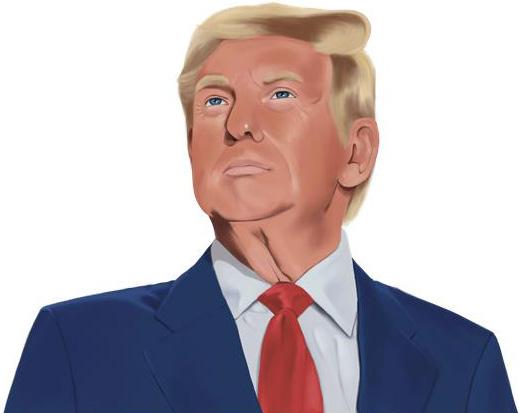
In response, AP issued a statement from Executive Editor Julie Pace, saying, “It is alarming that the Trump administration would punish AP for its independent journalism. Limiting our access to the Oval Offce based on the content of AP’s speech not only severely impedes the public’s access to independent
news, it plainly violates the First Amendment.”
By using his power to limit the scope of reporting to those who support his interests, Trump undermines journalists’ vital role in investigating and exposing government overreach and misconduct. This fundamental duty of the press, to hold power accountable, is greatly hampered under his presidency.
Additionally, one of the most dangerous consequences of Trump’s return to the White House may be that journalists will engage in self-censorship or alter their coverage as a means of “anticipatory obedience” to avoid persecution. It is both frightening and dispiriting that some of America’s largest media companies succumb to Donald Trump’s intimidation, offering obscene sums to settle frivolous lawsuits they once had the will and courage to contest.
Journalists must continue to publicize injustices and maintain their role as watchdogs despite censorship, press intimidation and a widespread smear campaign aimed at damaging media institutions’ prestige and credibility. More than ever, we need civic courage.
If, after reading this opinion piece, you feel disheartened and scared for the uncertain future that lies ahead, I’m with you. But as ProPublica’s Tofel advises, “Lick your wounds if you must, but indulge in that for just a moment. There is work ahead, maybe the most important of our lives.”
In a world where our own leader seeks to discredit the work of journalists and vilify the press, we must never forget the profound power our words carry.
SPORTS
PHOTO
GRAPHIC
PRINT EDITORS Charlotte DeAngelis Kelby James
COPY CHIEF
BUSINESS MANAGER
Patrick McCaslin
FACULTY ADVISOR
Antonio Mora
FINANCIAL ADVISOR
Steve Priepke
SENIOR FINANCIAL
ASSISTANT
Michelle Starbeck
Miami Hurricane is published biweekly during the regular academic year and is edited and produced by undergraduate students at the University of Miami. The publication does not necessarily represent the views and opinions of advertisers or the university’s trustees, faculty or administration. Unsigned editorials represent the opinion of The Miami Hurricane’s Editorial Board. Commentaries, letters and cartoons represent only the views of their respective authors. The newsroom and business offce of The Miami Hurricane are located in the Student Activities Center, Student Media Suite 200.
LETTER POLICY
The Miami Hurricane encourages all readers to voice their opinions on issues related to the university or in response to any report published in The Miami Hurricane. Letters to the editor may be submitted typed or handwritten to the Student Activities Center, Student Media Suite 200, or mailed to P.O. Box 248132, Coral Gables, Fla., 33124-6922. Letters must be signed with a copy of your Cane Card.
ADVERTISING POLICY
The Miami Hurricane’s business offce is located at 1330 Miller Drive, Student Activities Center Student Media Suite 200. The Miami Hurricane is published every other Wednesday during the university’s fall and spring academic terms. Newspapers are distributed for free on the Coral Gables campus, the School of Medicine and off-campus locations.
DEADLINES The conditions of agreement for advertisers are outlined on the ad contract form. Please direct any and all questions related to advertising to the Business Manager, Patrick McCaslin. Questions can be emailed to pkm492@ themiamihurricane.com.
By Sarah Landau Staf Writer
The Miami Hurricanes played their hearts out Sunday afternoon in an age-old faceoff with the Florida State Seminoles, falling 83-82 at their home court in Coral Gables, Fla.
Coming off of three losses prior to this matchup, the Hurricanes needed this win in order to establish themselves as a threat in ACC play. While the Seminoles (20-6, 10-4 ACC) snuck out the win, Miami (13-12, 3-11 ACC) gave its all in the game and demonstrated that it could compete with such a strong team.
For much of the first quarter, each possession became a scoring battle between the ’Canes and the ’Noles. Haley Cavinder, who was honored before the game for scoring her 2,500th career point this past Thursday, continued to provide for Miami by putting up 27 points and tallying seven assists.
While UM remained hot on the Seminoles’ heels for much of the game, it truly came to life in the fourth quarter, where the team went on a 10-point scoring run and briefly took the lead.
With 3.3 seconds left on the clock and the Hurricanes down by 1 with possession of the ball, Hanna Cavinder dished the ball to Natalija Marshall. She kicked it out to Cameron
Williams for a last-second shot, but it did not fall, and the ’Canes were left with the loss.
Although Williams missed what would have been the game-winning shot in the paint, head coach Tricia Cullop stated that the loss was not on her but instead a compilation of
small but impactful team errors.
“We did things throughout the whole game,” Cullop said. “It just happened to be the last play.”
One huge problem for the Hurricanes throughout the game was Florida State guard O’Mariah Gordon. She put on her best perfor-
mance of the season, dropping a career-high 34 points and leading her team with seven assists.
Miami had several standout performances throughout the game, including the presence of freshman Ahnay Adams.
“She continues to put herself
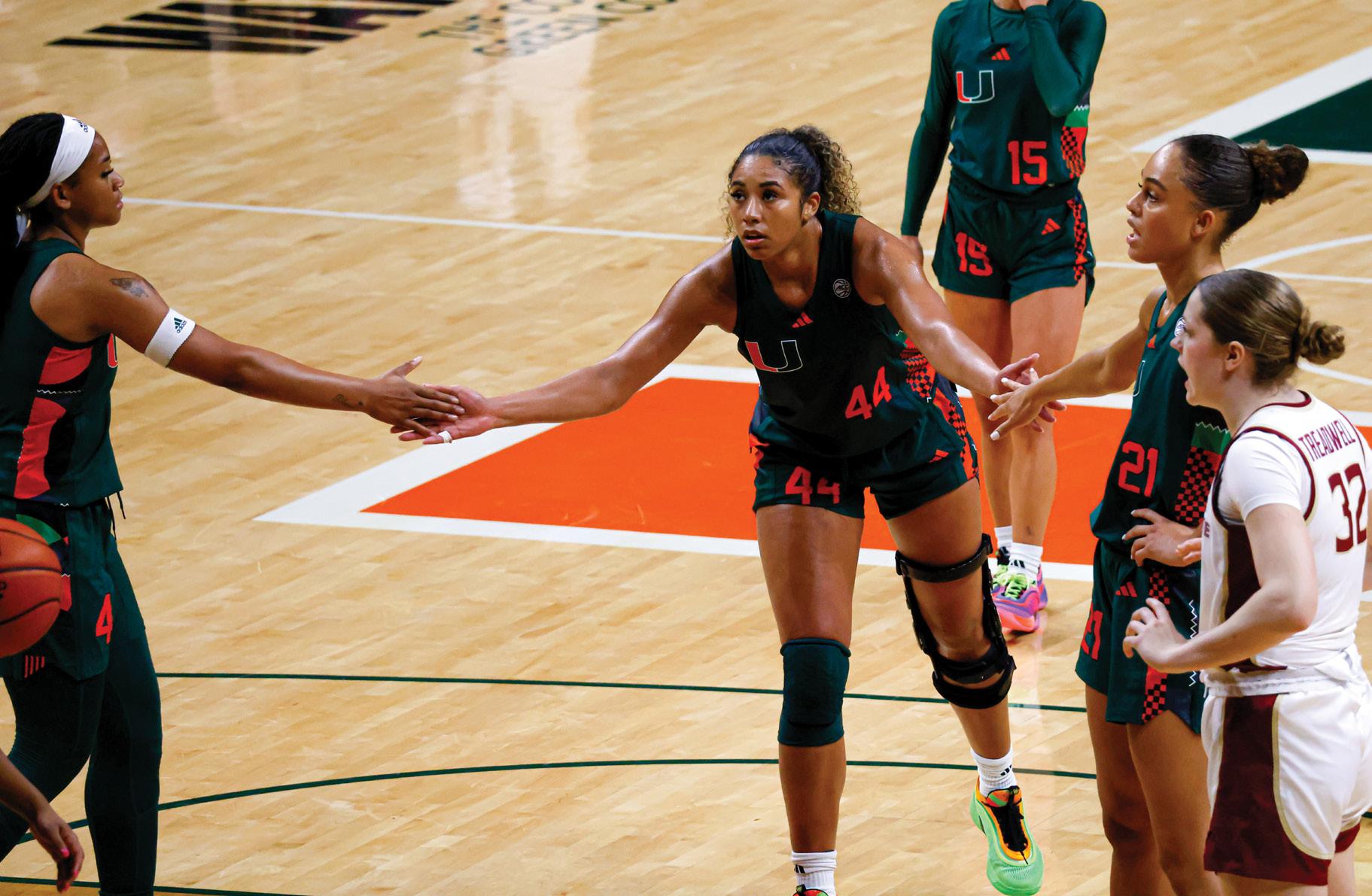
in harm’s way so we could have a chance to win games,” Cullop said about Adams. “She’s a big part of our future.”
Miami looks to gain more ACC wins under its belt with upcoming games against No. 2 Notre Dame and Wake Forest on February 20 and 22, respectively.
“[Adams] continues to put herself in harm’s way to win games. She’s a big part of our future.”
Tricia Cullop WBB Head Coach
By Zach Cohen Staf Writer
Coming off its statement win against the Syracuse Orange, Miami looked to snag another victory at Pittsburgh. As the Hurricanes have played more team basketball as of late, they had a strong showing against the Panthers. However, poor defense from UM and good ball movement from Pitt allowed it to seal a 74-65 win.
This loss for Miami minimizes its chances of sneaking into the ACC tournament, as it hoped to go on a bit of a run following the win over Syracuse.
Even with the loss, several Hurricanes players put up solid numbers. Graduate center Lynn Kidd put up 16 points on 5-on-6 shooting. He also nabbed 15 rebounds, 10 on the defensive boards. After a zeropoint performance against Syracuse, senior forward Brandon Johnson scored 12 points, going 4-of-9 from
the field. Redshirt junior A.J. Staton-McCray tallied 13 points, going 3-of-6 from downtown.
After Kidd won the tip, both teams started sloppily with turnovers and missed shots in the first two minutes. Pitt (15-10, 6-8 ACC) entered the scoring column first on a Cameron Corhen hook shot. Corhen played a pivotal role in his team’s victory, scoring 17 points.
Shortly after, Miami’s (6-19, 2-12 ACC) freshman guard Divine Ugochukwu used his speed to drive
to the basket for the easy layup.
This marked the beginning of a competitive first half. Each team traded buckets, but Pitt had the slight advantage, leading by as much as seven and as little as one throughout the half. Freshman Amsel Delalić buried a deep threepointer right before the first-half buzzer sounded. Delalić went on to score a career-high 14 points. At halftime, Pitt was up 32-30.
The first 15 minutes of the second half were similar to the first.
Pitt steadily led, but Miami was in striking distance thanks to the 12-point second-half effort of Kidd. Miami had chances to tighten the gap or even take the lead if it didn’t shoot the three-ball at an 11% clip. In the last five minutes, the Hurricanes slowed down and wore out, something that has been an issue in many games past. This resulted in Pitt seizing a favorable advantage down the stretch. The Panthers brought the lead to as much as 11 and won by nine, 74-65.
By Sebastian Font Staf Writer
’Canes baseball began its 2025 season 3-0 after sweeping the Niagara Purple Eagles (0-3) in dominant fashion. Hurricane fans were treated to three quality games after a long offseason, winning 14-2, 10-0 and 11-1, respectively.
After a disappointing sub-.500 record last year, head coach J.D. Arteaga plans to lead his new-look squad back to the typical success of Miami baseball.
“All in all, great weekend. The fans were great … We’re excited about what’s to come,” said Arteaga to reporters after the game on Sunday.
Here are three takeaways after the opening series.
Taking Care of Business
First off, the quality of the opponent has to be considered. Niagara had only been outside to practice twice before this weekend, and it showed. The Purple Eagles looked ill-prepared to take on an ACC opponent. with countless errors from misplaying fly balls to booting ground balls
across the diamond.
Miami took care of business in a dominant fashion. Across the three games, UM outscored Niagara by 32 runs, only being behind for a single inning. Pitching was in control from the start to the finish of each game, with the staff combining for 38 strikeouts on the weekend. The hitting followed suit, with 36 hits across the three games.
The balance of pitching and defense bodes well as Miami continues to prepare for higher-level competition.
Across all three games, each of the weekend starters delivered a promising performance, but the Saturday/ Sunday pair of junior Griffin Hugus and redshirt junior Brian Walters impressed fans and scouts alike. The two combined for 21 strikeouts across 11 innings, carving up hitters as they pleased.
Hugus’ fastball delivered as advertised, a great rise that left hitters consistently under the ball and struggling at the plate. But as the game developed, he leaned on his offspeed, which proved equally as effective — a dominant display in
his Hurricane debut.
“When your starter does a job the way Griffin did today, it makes everyone’s job a lot easier,” Arteaga said.
Walters initially struggled with command in his first inning, result ing in a run given up. But after that, he was completely dominant and ef ficient. His mid-90s sinker proved a problem for Niagara’s lineup, consistently generating swings and misses.
Both former relievers proved they could make it to the five-in ning mark, which could be a sign of things to come for the talented pair.
With so many positives from open ing weekend, the veteran approach across the series stood out. From a lineup with a great balance of right ies and lefties to quality approaches at the plate, the squad projects to give opposing teams a headache when trying to gameplan.
Moreover, no one player solely carried the team throughout the weekend. From Tanner Smith con necting on multiple extra-base hits to Bobby Marsh dominating on Opening Day, going 4-for-4 at the

By Shea McDonald Staf Writer
Hurricanes track and field had a busy weekend at the Tiger Paw Invitational, breaking records and setting new highs.
Distance runner Maddie Scheier made the biggest waves, shattering a 20-year-old record in the mile. Scheier’s time of 4:45.82 beat Melanie Schultz’s time from March 2005. This is now the second record Scheier has broken this year after taking the indoor 1000-meter record a month ago at the Gamecock Opener. Though she finished sixth in the race, the sophomore out of New Jersey is clearly setting herself up for a strong finish to the spring season.
Scheier wasn’t the only distance runner to take home a new record, as junior Gabriella Grissom also broke a 2021 record set by Kayla Johnson in the 800m. Grissom hit the mark of 2:03.01, breaking the record by 0.79 seconds and her previous best by 1.73 seconds. Just like Scheier, Grissom also broke another record at the Gamecock opener when she took the top spot for the 600m.
The last notable record from the weekend was in the 4x400. The relay team was made up of juniors Sean Watkins Jr. and George Franks as well as grad students Solomon Strader and Lance Ward. It’s the second time the record has been broken this season, as this same group, aside from sophomore Ace Malone instead of Ward, took the top spot at Texas Tech in Jan-
uary. The group’s time of 3:06.4 took the record by just .75 seconds.
As indoor ACC and NCAA championships get closer, the group Miami fields is something to watch. Regardless, you can expect Strader, who in the solo 400m set a new personal best, to be a factor if Miami sends out the same squad.
Miami had several other standout performances outside of these records, primarily in the field events. Miami’s sole first-place finish of the weekend came from sophomore Calea Jackson in the weight throw. Her distance of 19.8 m was good for first place by a solid 0.35 meters. This is Jackson’s best performance of the season and overall a new personal best. Heath Vernor also set a new personal best with his fifth-place fin-
ish for the men’s weight throw, improving on his current fourth all-time mark. Over in the triple jump, Christina Warren set a new personal best and took second place with a mark of 13 meters.
Back on the track, several notable performances moved several ’Canes higher in the record books.
A particular freshman has come on strong to start the year. Caine Stanley out of IMG Academy (Fla.) has already cracked the Miami top five for the 200m. With a time of 21.20, he moved into third after entering the top five at the PNC Invitational a couple of weeks ago. He jumped teammate Sean Watkins Jr. by just .09 seconds.
Senior Cormac O’Brien also had himself a weekend, setting two new
personal bests in both the mile and 3000m races. His time in the 3000m at 8:21.64 moved him into the third spot all-time in the event. Rounding out Miami’s standouts from the weekend, senior Josh Jones set a new personal best in the mile, improving on what is currently the fifth fastest time in school history.
As the indoor season comes to a close, many of Miami’s stars are peaking at the perfect time of the season. With Louisville right around the corner, it’ll be interesting to see if any ’Canes are able to push themselves further. The ACC Indoor Championships are in two weeks from March 1 to 3. After that, the NCAA Indoor National Championships will be in Virginia Beach March 14 and 15.
By Sebastian Font Staff Writer
367 drafted players, 67 first-round picks and 11 Hall of Famers: that’s the legacy Hurricanes football has with the NFL. Miami has been a long-standing factory of NFL players for decades, and this year looks to be no different. But before draft night commences in Green Bay in April, some star players get invited to the NFL Draft Combine, which is from Feb. 27 to March 2 at Lucas Oil Stadium. This allows the prospects to showcase their talent and improve their draft stock. From measurables and drills to interviews and tests, the combine could be make or break for draft hopefuls. The ’Canes will be well-represented at the combine, with 10 players invited to participate.
Miami Combine Invitees:
QB Cam Ward
RB Damien Martinez
WR Xavier Restrepo
WR Jacolby George
WR Sam Brown
TE Elijah Arroyo
OL Jalen Rivers
DE Tyler Baron
LB Kiko Mauigoa
K Andy Borregales
After a 2024 season where the ’Canes displayed the most electric offense in the country, seven players from that side of the field made the combine. Headlining the invitees, Cam Ward hopes to be UM’s third No. 1 pick in its history. Ward’s stock is already at an all-time high after his Heisman finalist season, so it’s still undetermined whether he will participate in the combine.
But for other Miami players, the combine could make all the difference in their draft stock. Players like Elijah Arroyo and Xavier Restrepo have impressed scouts in the recent Senior Bowl and could find themselves being selected early in the draft after a good combine performance. Moreover, for fellow Senior Bowl participant Damien Martinez, a good combine could mean the difference between being a late-round selection and a mid-round pick.
The wide receiver pairing of Jacolby George and Sam Brown Jr. also received an invite, looking to impress scouts and have their names called in the latter rounds on draft night. One of Ward’s best protectors, Jalen Rivers, looks to climb the offensive lineman rankings at the combine.
On the defensive side of the ball, only two players received an invite to the combine. Defensive end Tyler Baron looks set to be the highest Miami defender drafted in the class with a mid-round grade. Likewise, linebacker Francisco Mauigoa is expected to be drafted in the mid to late rounds. Both hope to impress scouts at the combine and improve their stock significantly.
Rounding out the invitees is Miami’s all-time points leader, kicker Andy Borregales. While his drills are relatively straightforward, his competition may be the toughest. Very few kickers get drafted, as many are signed as undrafted free agents. Still, performing well at the combine is a great way for kickers to get on scouts’ radar and earn a spot in the league.
Two standout players from Miami’s
2024-25 team that did not receive invites were defenders Simeon Barrow Jr. and Elijah Alston, who could be selected with late-round picks.
For all 10 of the invitees, a combine spot is a testament to their talent and hard work.
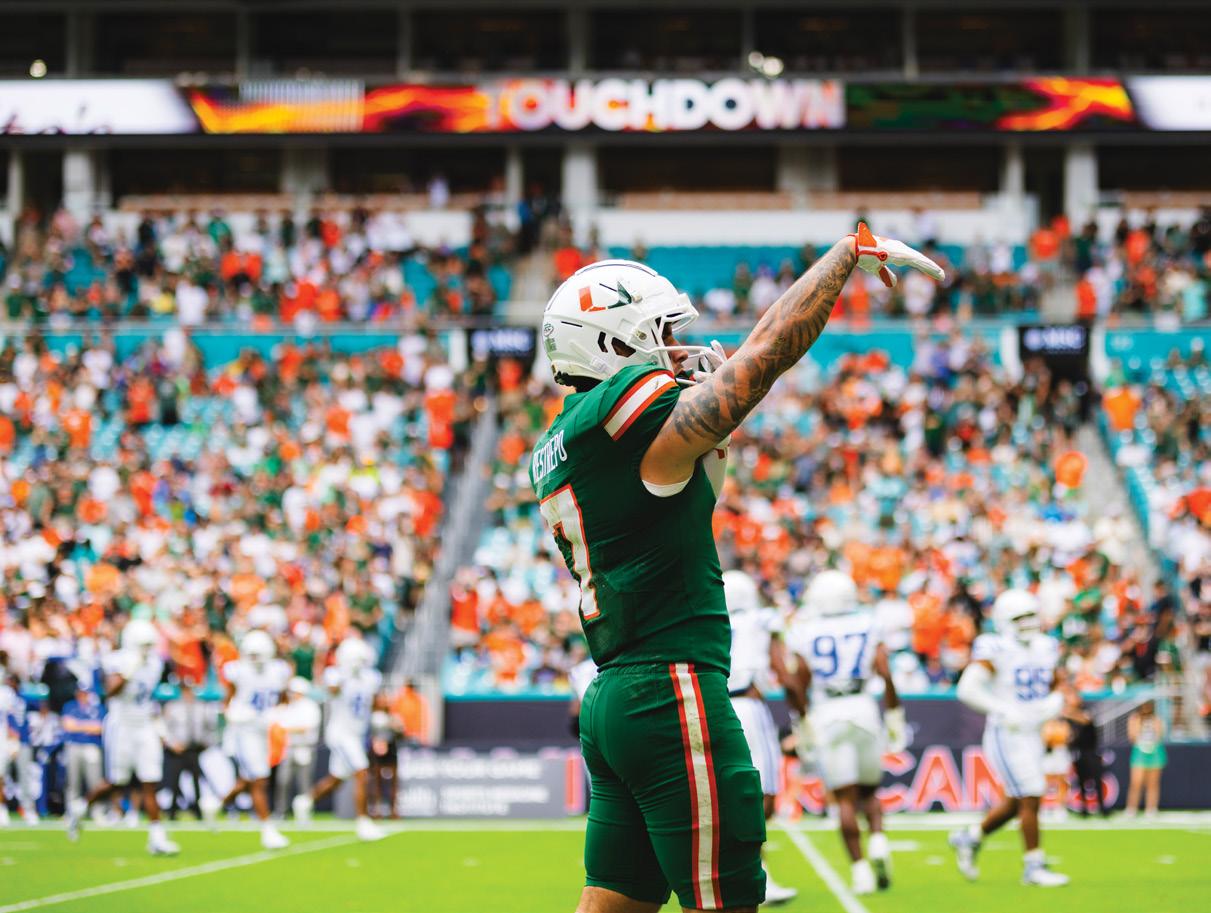
Fifth-year senior wide receiver Xavier Restrepo celebrates after winning Miami’s first touchdown in their game against Duke University at Hard Rock Stadium on Saturday, Nov. 2, 2024.
By Luke Sims Co-Sports Editor
Football in Coral Gables won’t kick off for more than seven months, but it’s never too early to take a look at who might be taking the field for the Hurricanes this fall. The ’Canes have been active in the transfer portal and have another highly rated recruiting class coming in again this year.
It’s Year 4 under head coach Mario Cristobal and Year 1 without quarterback Cam Ward. The Hurricanes will lose a ton of offensive pieces to the NFL Draft, so younger players will need to step up. Miami is full of talent, and while there are still moves to be made, here is what the depth chart could look like this season.
Offense:
QB: Carson Beck, SR.
RB: Mark Fletcher Jr., JR.
RB: Jordan Lyle, SO.
WR: CJ Daniels, SR.
WR: Joshisa Trader, SO.
WR: Ny Carr, SO./FR.
TE: Elijah Lofton, SO.
OT: Markel Bell, SR.
OG: Matthew McCoy, JR.
OC: James Brockenmeyer, SR.
OG: Anez Cooper, SR.
OT: Francis Mauigoa, JR.
This offensive group is hurting from the loss of its signal caller and its top three wide receivers. Still, Beck is a championship-caliber quarterback who can succeed in offensive coordinator Shannon Dawson’s offense. Fletcher and Lyle will be an exciting one-two punch with a unique blend of speed and power.
The ’Canes will rely on the LSU transfer Daniels to provide a good chunk of offense, but there are plenty of targets to go around for Trader, who showed out during the bowl game. Miami has brought in some young, talented wideouts over the last two receivers in its recruiting classes, and now is the time to let them
see the field. Another young pass catcher is Loften, who was used all over the field last season. He’ll be a focal point of the offense this fall.
Along the offensive line, the ’Canes lost two starters at center and left guard. But, bringing in Brockenmeyer from TCU is very similar to getting Zach Carpenter from Indiana last season. Both Bell and McCoy got time last season and should be trusted to hold the left side of the line down again this season.
The Hurricanes will miss Ward and Restrepo along with their starters at tight end, plus the other wideout positions, but they’ve restocked the cupboard on offense and look to continue their highflying ways.
Defense:
DE: Ahkeen Mesidor, SR./Hayden Lowe, FR.
DL: Justin Scott, SO./David Blay, SR.
DL: Armondo Blount, SO./Bain
DE: Rueben Bain Jr., JR./Blount
LB: Raul Aguirre Jr., JR.
LB: Wesley Bissainthe, SR.
CB: Charles Brantley, SR.
CB: Xavier Lucas, SO.
CB: OJ Frederique Jr, SO./Ethan O’Conner, SO.
SS: Zaquon Patterson, SO.
FS: Zachariah Poyser, SO.
There’s a new defensive staff in town led by play caller Corey Hetherman, who led his Minnesota defense to a top-five unit this past season. Hetherman had tremendous success with his defensive backs, and Miami brought in three new potential starters, one at safety and two at corner. The Hurricanes’ secondary was the weak link last season, and they’ve gone above and beyond trying to fix that issue.
The linebacker core struggled last season, but with Mauigoa leaving, the ’Canes are bound to improve in their weakest area: pass coverage. Bissainthe brings experience, and Aguirre plays like every single snap will be his last. More
time in the system will lead to a better outcome for Miami on that level next season.
The front seven might be the most talented group that Miami has. From five stars in Lowe, Scott and Blount to returning studs like Mesidor and Bain, Miami is set to control the trenches while constantly keeping players fresh with its abundance of talented depth.
Special Teams:
K: Carter Davis/Abram Murray
P: Dylan Joyce
LS: Adam Booker/Micheal Donovan
For these special teams battles, it’s hard to tell exactly how it will shake out with the transfers in Davis and Booker. There is still the spring transfer window and lots of practice time between now and opening kickoff on Aug. 31 at home against Notre Dame. But, Miami has a ton of talent taking the field this fall, and with this depth chart, the ’Canes would be set up for success next season.
Unapologetic. Bold. Unfiltered.
V’s Take is a satirical work published biweekly by students and for students using our generation’s “colorful” language. V addresses all things love, sex and gossip on campus. V is not for the politically correct or easily offended.
Hey V, I think my twin XL is too small for sex. What should I do?
Dear V, I accidently introduced my parents to my talking stage. Help.
Valentine’s Day just passed and some of us singles are horny and frustrated after being forced to scroll through Instagram stories of your troll boyfriends. Spring is right around the corner, so why not get in the holiday spirit and get it on like bunnies.
A nice hookup can be a great break from the stressors of college life. But for the students that live in the dorms on campus, there’s some logistical planning that has to be done before getting freaky. For starters, in an ideal world, your roommate is out of town and you have the place to yourself.
The next, and trickiest part of the deed, is finding the space to do it. A dorm room twin might not be the best to have sex in, but rest assured, there are some workarounds. You just have to be a little bit … creative.
The Eaton eater
Eaton is definitely a sore sight compared to the other dorms here. You can feel its age with every creak and crack of its outdated dorm furniture. But don’t let that stop you from trying to make that bed rock.
To avoid the noise complaint, do something with less force, but double the fun. Time to show them what that mouth do.
For those of you with a twin bed, it might be okay for sleeping by yourself, but not the best for sleeping with someone else. If you and your partner are looking to get a little more mobile and don’t want to risk banging your head while banging, push some beds together! You’ll have to ask your roommate for permission, or maybe just thoroughly wash their sheets after and beg for forgiveness.
After all, what’s more important? Your roommate’s perception of you or being able to switch who’s on top without rolling off the
bed? Uninhibited movement is priceless.
The Albenga “Bang-Ya” or the Pavia “Put it In”
Sometimes you can’t bring your link over, but you still want to fool around. If neither of you can host, but you’re still horny as hell, try a little carplay (not the Apple one). Sure, the campus garages may have cameras, but they’re only there to squeeze every last cent out of you for parking violations. Just park in a garage (that you have a pass for of course), find the highest corner and crank up the tunes.
Just don’t get caught, V is not liable for any legal repercussions if UMPD comes knocking on your window!
The shower sex 100
The new Centennial Village dorms have a lot to show for, including completely private, unisex, communal bathrooms that feel like an invitation. While dorm shower sex isn’t new, these new bathrooms make it cushier than ever. Doors that lock, with a shower inside? And a toilet? You can hook up and pee after, all within the comforts of a private bathroom stall. UM really thought of everything!
The Lakeside view
The final boss of dorm room sex. With windows that bare it all, it’s all too easy to become the on-campus Red (LED) Light District. While some of you may be exhibitionists at heart, most of us walking to the metrorail at 12 a.m. after finishing a paper aren’t looking to be your voyeurs.
So if you find yourself fooling around in a Lakeside dorm, please, check all your angles. Be a dear and pull down the blinds before you pull down your pants, unless you want your gooch and cooch out for all the world to see.
